

| Name | Description | Object ID | |
|---|---|---|---|
 |
Hinaningyō Doll |
This Nō dancer doll is intended for display during Hinamatsuri (the Doll Festival). The doll is portrayed kneeling on one knee; he has a stiff topknot tied with a green cord and wears a richly brocaded silk kimono in gold, blue, red, and green with wide tan silk... |
2004.10.2 |
 |
Randoseru Backpack |
This red child's backpack, called a randoseru, contains various school supplies and other items. The bag is red leather or vinyl, in a rectangular shape. The red color is traditionally used by girls, while boys favor black backpacks. The metal clasp, on which the word "Atomu"... |
2006.X.102 |
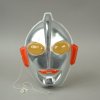 |
Ultraman Mask |
This child's costume mask represents Ultraman, the superhero from a futuristic Japanese television series. The mask is made of plastic silver with transparent orange eyes, and a red mouth and ears. A fin runs down the middle of the forehead. Ultraman was a Japanese television series... |
2006.X.112 |
 |
Toy Rabbit |
This small papier-mâché rabbit is mounted on a wooden stand, and features a white body decorated with colorful designs and large ears. It would have been one of twelve papier-mâché animals in a collection representing the 12 signs of the zodiac. The Japanese zodiac is divided into 12... |
2006.X.114 |
 |
Photo Album |
This photo album has a cover decorated with a violet flower in a green vase and some Japanese text that reads "Stars in Heaven, Flowers in the Ground, Love in People" on the right-hand side. The spine is tied with a green string. The album is a reproduction of the family photo album of a girl... |
2006.X.199 |
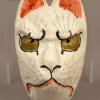 |
Kitsune Mask |
This papier-mâché mask represents a kitsune, or fox. It has a white face, gray whiskers, pink ears and mouth, and gold eyes. The interior of the mask features a manufacturer's tag and a painted inscription. Kitsune (foxes) are common figures in Japanese folklore, where... |
2006.X.59 |
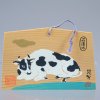 |
Ema |
This is a small wooden ema, or votive plaque, that is painted with a design of a cow sitting on grass below a gold cloud. There are several inscriptions with Japanese characters and a red stamp at the bottom left. A blue cord tied through small hole drilled at top would allow the buyer... |
2006.X.68 |
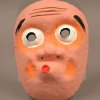 |
Hyottoko Mask |
This papier-mâché mask represents the comical figure Hyottoko. Here, he has a pink face with lines on his forehead, his eyebrows are painted black, and his mouth is puckered. The white circles of the eyeballs are painted around large holes. There is an elastic band around the back of the mask... |
2006.X.71 |
 |
Abacus |
This abacus has a black frame with wooden rods and white counting beads. An abacus, or counting frame (soroban in Japanese), is a tool originating in Asia that is used for arithmetic. It was imported to Japan from China around 1600. Merchants, traders, and clerks in some parts... |
2006.X.84 |
 |
Uwabaki Shoes |
Uwabaki are a type of indoor shoe, in this case to be worn at school. This pair is for a young girl and is beige with a canvas top, rubber soles and an elastic strap. There are words written in hiragana (phonetic Japanese characters) at the top toe area of the shoes, which... |
2006.X.85 |
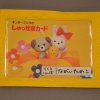 |
Planner |
This small student planner keeps a record of attendance and has a yellow plastic cover with animal cartoons on it. The cartoon figures include a brown bear, a pink rabbit with a red bow, and a round orange face sitting among a bouquet of flowers. There are illustrations throughout the pages of... |
2006.X.86 |
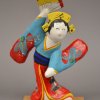 |
Miharu Ningyo |
This painted papier-mâché Miharu ningyo (doll) represents a dancing female figure. She is wearing a brightly colored kimono in red, yellow, green, pale blue, dark blue, lavender and white, and holds an open sensu (folding fan) above her head in her right arm. The ... |
2009.102.1 |
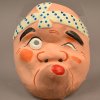 |
Hyottoko Mask |
This papier-mâché mask represents Hyottoko, a character from Japanese folklore. It is painted on front in a skin tone; its face has one white eye wide open (with an eye hole) and the other eye winking. The eyebrows, eye lashes, and nostrils are all painted in black, while the cheeks and wrinkle... |
2009.103.1 |
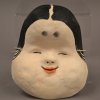 |
Okame Mask |
This painted papier-mâché face mask represents Okame, or Otafuku, a figure from Japanese folklore who is considered the goddess of mirth. She is recognizable by her bulbous cheeks and forehead, as well as her expression of happiness. She is painted in a light skin tone with black hair, light... |
2009.104.1 |
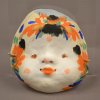 |
Okame Mask |
This painted papier-mâché mask features Okame or Otafuku, the "homely woman," a figure from Japanese folklore known as the goddess of mirth. She is recognizable by her bulbous cheeks and forehead. She is painted on the front in white with small patches of black hair visible beneath a decorative... |
2009.104.2 |
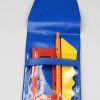 |
Clay Working Tools |
This set of three plastic clayworking tools in a plastic carrying case includes one orange plastic stylus with a round point on one end and a square point on the other, one pink plastic cutting tool/dough scraper, and one flat plastic yellow knife tool with a tapered handle. All are stored in... |
2009.105.1 a-d |
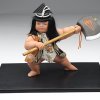 |
Kintaro Doll |
This ceramic male warrior doll depicts the folk hero Kintaro, the Golden Boy. He is characteristically chubby, and is painted in skin tones with white fingers and toenails. His long, black synthetic hair is topped with a black ceramic hat, held on by white nylon rope. Kintaro is positioned in a... |
2009.108.1 |
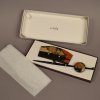 |
Hair Accessory Set |
This boxed set of hair ornaments includes two lacquer pieces in a silver gift box. The lacquer pieces include: (a) a black lacquer comb with a floral design in red, gold, beige and silver on one side, and a botanical motif in gold on the reverse; and (b) a black lacquer hairpin with a matching... |
2009.110.1 a-d |
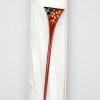 |
Hairpin |
This red lacquer hairpin (a) comes in a white cardboard box (b) with a lid (c) that is covered in textured silver paper. The hairpin tapers to a point at one end and widens into a fan shape at the other end. It is decorated with a floral motif in black and gold on one side and a botanical motif... |
2009.113.1 a-c |
 |
Buyare Ushi-oni Puppet |
This papier-mâché puppet (a) buyare ushi-oni (demon cow) is a miniature version of a parade float-sized buyare used in the Warejinja Shrine festival in Uwajima. The ushi-oni has a red, hollow papier-mache body shaped like half of a pear laid flat. A splatter of gold... |
2009.114.12 a-c |
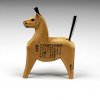 |
Wooden Horse |
This wooden standing horse figurine (a) is unpainted. One side of the body is inscribed with the first seven lines of the famous Kenji Miyazawa poem, "Ame nimo makezu" ("Be Not Defeated by the Rain") in black ink. The ear, nose, eye, and mouth details are also added with black ink. A... |
2009.114.30 a-c |
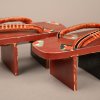 |
Geta |
This pair of red wooden geta features a rectangular footbed with rounded corners. The top, bottom, and outer sides of the heels are painted red, and there are three flower designs in red, pale yellow, black and blue-gray painted on the footbed of each shoe. The insides of the heels are... |
2009.124.1 ab |
|
|
Anesama Ningyō Doll |
This is a paper anesama ningyō ("big sister doll"). Her head and voluminous hair are made from twisted white paper. Her kimono is made from an inner sheet of folded red paper under an outer layer of folded red paper with a white floral pattern, and her obi... |
2009.132.1 |
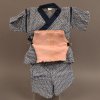 |
Jinbei/Haramaki |
This jinbei (summer loungewear) is meant for a young boy. The set comes with a haramaki (literally, "belly warmer"), a stretchy item of clothing worn around the stomach to increase circulation and provide warmth. The jinbei is blue and white with a geometric star... |
2009.169.1 a-c |
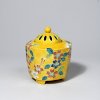 |
Incense Burner |
This yellow ceramic incense burner, called a kōro in Japanese, features a sakura (cherry blossom) design with pink blossoms amid other blue and white flowers with green leaves. The incense burner is an octagonal shape, with three legs and a round, perforated lid with a knob.... |
2009.175.2.1-2 |
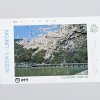 |
Telephone Card |
This telephone card features a photograph of a traditional Japanese scene with blooming sakura (cherry blossoms) in the foreground and a forest in the background, with a river and bridge in between. A label in the white border reads "Nissay Union" in blue in English. The back of the... |
2009.180.9 |
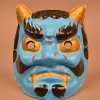 |
Oni Mask |
This blue Japanese oni mask was probably used during festivals. The oni has gold horns and fangs, as well as black hair with thick, flaring eyebrows and a mustache and goatee. It has glaring gold eyes and red accents. It is worn by using the attached elastic band. In Japanese... |
2009.194.1 |
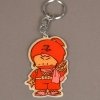 |
Ninja Key Chain |
This metal key chain is in the shape of a ninja, likely a specific character from a popular manga series. The ninja is dressed in red with a pink scarf and socks, a white belt, and a black and tan, cross-hatched pattern. The ninja is reaching for a sword with his left hand, and holds a... |
2009.195.1 |
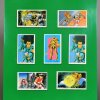 |
Trading Cards |
This set of seven Japanese trading cards features anime characters from the show "Saint Seiya." There are four horizontal and three vertical trading cards, all rectangular; two of the vertical cards are identical. The cards are attached to a rectangular sheet of glossy green cardstock... |
2009.199.1 a-g |
|
|
Costume Doll (Ishō Ningyō) |
This isho-ningyo ("costume doll") represents a geisha performing a fan dance. She wears a furisode kimono, a type of kimono with floor-length sleeves intended for unmarried women. There are two layers of kimono, each with a puffed... |
2009.72.1.1 |
 |
Snow Boots |
This pair of child's yuki-gutsu (also called fuka-gutsu), or snow boots, are made of woven straw. Straw was used to keep out moisture and cold when walking in the snow. There is a tight side-to-side weave across the soles. Open vertical straw staves are bound with black twine... |
2009.94.1 a-b |
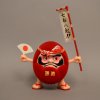 |
Wind-Up Daruma |
This battery-operated plastic Daruma is covered in red felt. Its arms, legs and face are molded in peach-colored plastic, and it wears red sandals on feet. The Daruma holds a plastic sensu (folding fan) in his right hand and holds a synthetic cloth banner in left hand. The fan has a... |
2010.15.1 |
 |
Egg Dolls |
This pair of dolls is made from chicken eggs by an artist named Setsuko Miki. The pair includes one boy and one girl egg doll, each dressed in traditional Japanese costume. The boy doll (2010.9.1) has a tuft of hair at the top of his head, drawn-on features, and wears a black silk floral print... |
2010.9.1-2 |
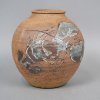 |
Vase |
This large red clay zogan-ware vase, by the artist Masayuki Imai, is a red-brown color flecked with black. The front features an image of a roughly incised lobster (called an "oo-ebi") filled with grey and reddish/brown glaze. Masayuki Imai (b. Osaka 1930) began... |
2012.1.3 |
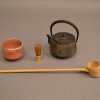 |
Tea Ceremony Objects |
This tea ceremony set includes a cast iron teapot, a hishaku (bamboo ladle), a sasara (whisk), and a ceramic chawan (tea bowl). This small teapot is decorated in relief on the sides with a landscape image featuring a temple, trees, and a stupa on one side. On the... |
2012.12.1-4 |
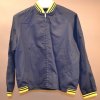 |
Jacket |
This late 20th-century boy's navy jacket has a zip front. The collar, cuffs, and bottom hem feature a yellow-and-navy striped knit pattern. The fabric is a polyester/cotton blend. |
2012.3.1 |
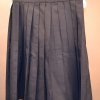 |
Uniform Skirt |
This girl's navy pleated skirt is part of a school uniform. The skirt has a back zipper (pulling from the seam), and is missing either a button or a clasp at the waist. The fabric is a cotton/polyester blend. This skirt is part of a "sailor fuku," a common style of uniform worn... |
2012.3.2 |
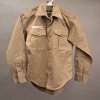 |
Boy Scout Uniform |
This khaki-colored outfit is part of a Boy Scout uniform. The two pieces of the uniform include a pair of shorts and a long-sleeved shirt, both made of a cotton blend. The tag on the shirt is in Japanese and translates to "Boy Scout Association of Japan." The shirt has two breast pockets with... |
2012.3.3 |
 |
Jacket |
This navy letterman/varsity jacket is made of velour with a navy-and-white striped knit collar, cuffs, and hem. There is a zip front and a gray satin interior lining, as well as two pockets. A label reading "Paradise, Made in Vacation" with a fish and a number is on the inside collar. There is... |
2012.3.4 |
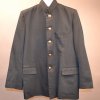 |
Uniform |
This boy's high school uniform, also known as gakuran, includes two pieces: a jacket and gray wool pants. The jacket has a mandarin collar, five brass buttons down the front, two brass buttons on each sleeve, and three pockets. There are two labels, one in Japanese and one in English.... |
2012.3.5 |
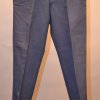 |
Uniform Pants |
This pair of pleated pants is part of a boy's high school uniform, or gakuran. The pants are blue and made of a wool blend. There is no waistband, but they have two front pockets and two back pockets (one with buttons). They are creased in front and cuffed at the bottom. Traditionally... |
2012.3.7 |
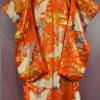 |
Wedding Kimono |
This red silk wedding kimono is called an uchikake. The kimono is decorated with a crane and flower design. Because cranes have long life spans, they have come to symbolize long life and good fortune, making them an ideal symbol for a marriage. This kimono ... |
2012.4 |
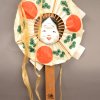 |
Post |
This ceremonial post was used for the beam raising of The Japanese House at the Boston Children's Museum. The post is made of cedar with Japanese text translated as "Kyo no Machiya Beam Raising Ceremony; Hosted by Kyoto and Boston"; date: "Auspicious Day, Showa 54 [1979], July 25." The text also... |
2012.5.2 |
|
|
Furisode Kimono |
This furisode (long-sleeved/"swinging sleeves") silk kimono is intended for a young, unmarried woman to wear to a coming-of-age celebration or other special occasion. It is made of ivory silk with a pattern woven into the fabric and a batik-like floral decoration. There is a... |
2012.6.2 |
|
|
Furisode Kimono |
This silk furisode (literally "swinging sleeves," a long-sleeved kimono) is for a young, unmarried woman to be worn for a coming-of-age celebration or other special occasion. The kimono has an ivory background and features nature and landscape scenes: flowers, water,... |
2012.6.4 |
|
|
Uchikake |
This silk wedding kimono (uchikake) has long sleeves (furisode). It was made by the company Hayashi Kimono, whose name and logo are on a paper tag attached to the garment. It has a cream-colored background with a textured pattern of birds (perhaps cranes or pheasants... |
2013.4.1 |
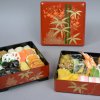 |
Osechi-ryōri Lunch Box |
This two-tiered lunch box contains a variety of food that is referred to as osechi-ryōri. The container is known as a jūbako, or tiered or stacked lunch box; it is made of red lacquer and features a winter-themed design of orange plum blossoms, pine branches, gold bamboo... |
2013.XX.11 |
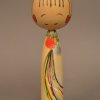 |
Kokeshi Doll |
This kokeshi doll, a traditional Japanese doll consisting of only a body and a head, is decorated with kusudama and fukinagashi, traditional decorations for the Tanabata summer star festival. The doll is painted with black hair tied in pigtails with red bows, red and... |
2013.XX.30 a |
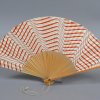 |
Sensu |
This sensu (folding fan) has a paper mount on bamboo ribs and guards. A single red stripe runs lengthwise along the guard. The paper mount has a decorative diagonal black-and-red striped pattern, done in a calligraphic style of thin and wide lines. There is a string at the end of the... |
2013.XX.9 |
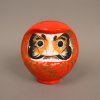 |
Teen Tokyo Daruma |
This traditional papier-mâché Daruma doll was purchased at the start of the Teen Tokyo exhibition process. One eye was filled in at that point, according to Daruma doll custom: the blank second eye serves as a reminder to persevere and complete a goal or task. The second eye was filled... |
2014.XX.10 |
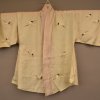 |
Jacket |
This pale silk kimono-style jacket features a three-inch edging of orchid silk and a pale blue lining. The jacket is embroidered with small black and white cranes in flight, scattered over the garment. Cranes are symbolic of long life in Japanese culture. |
AB 1 1002 c S3 |
 |
Wedding Kimono |
This cherry-colored silk wedding kimono (uchikake) is embroidered with flowers, cranes (tsuru), and butterflies scattered throughout the entire kimono in white, pale pink, chartreuse, gold, blue, and gray. Due to their long lives,... |
AB 1002 s1 |
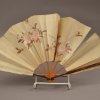 |
Sensu |
This sensu, or folding accordion fan, has wood guards that feature identical designs of mountains and a small pagoda. There are six bamboo ribs. The mounted paper has a sheen to it; one side is painted with an image of sakura (cherry blossoms) with young, reddish-brown leaves... |
AB 1006 |
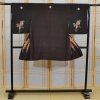 |
Haori Coat |
This haori (traditional coat) is intended to be worn over a kimono. The jacket is knee-length and reversible. The haori is black on one side with wisteria blossoms painted on both sides of the sleeves in yellow and orange; the leaves are green and maroon. The front... |
AB 1007 |
 |
Chopsticks |
This pair of ohashi (chopsticks) is made of bone, likely deer antlers from the sacred deer in Nara. The chopsticks feature an image of a deer, a lantern, and a temple. They are thin, rectangular at the top, and taper to a point. Chopsticks are short, usually tapered sticks used... |
AB 1031 s2 |
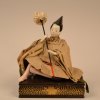 |
Hinaningyo Doll |
This court servant doll is part of a Hinamatsuri (Girls' Day or Doll Festival) set of dolls. In a traditional Hinamatsuri arrangement, the doll would be positioned on the fifth tier. The doll has a white composition face, red painted lips, and black hair tucked under a skiff. He wears a narrow... |
AB 1055 dd |
 |
Hinaningyo - Empress Doll |
This empress doll is part of a Hinamatsuri (Girls' Day or Doll Festival) set of dolls. She is dressed in a red and gold brocade kimono and wears a gold headdress. There are two spots painted on her forehead and she has long, black, styled hair, in Heian-era fashion. There are two... |
AB 1055 f |
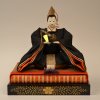 |
Hinaningyo - Emperor Doll |
This emperor doll is part of a Hinamatsuri (Girls' Day or Doll Festival) set of figures. He is dressed in a black brocade kimono with a red and gray satin lining, and he wears a gold cap. There are two spots on his forehead. He sits on a white cushion on top of a striped cushion, which... |
AB 1055 g |
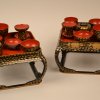 |
Kakebanzen Tables |
This pair of identical miniature tables are called kakebanzen, and are part of a Hinamatsuri (Girls' Day or Doll Festival) set of figures. The tables are made of black lacquer with gold decorations and red lacquer tops. The legs are curved and joined at the bottom. There are nine... |
AB 1055 k,l |
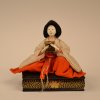 |
Sannin Kanjo Hinaningyo Doll |
This lady-in-waiting hinaningyō doll is part of a Hinamatsuri (Girls' Day or Doll Festival) set of dolls. One of the sannin kanjo (ladies in waiting), she would be positioned on the second tier in a traditional Hinamatsuri arrangement. She is seated, holding a black lacquer... |
AB 1055 p |
 |
Sakura Tree |
This miniature sakura (cherry tree) is part of a Hinamatsuri set of dolls. It would be placed on the fifth tier amid servants and guards in a traditional arrangement. The tree is composed of four wooden trunks with pink cloth blossoms and buds. It is enclosed by a wooden grillwork... |
AB 1055 r ww |
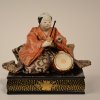 |
Hinaningyo Musician Doll |
This court musician doll is part of a Hinamatsuri (Girls' Day or Doll Festival) set of dolls. One of the gonin bayashi (five musicians), the doll would be positioned on the third tier in a traditional Hinamatsuri arrangement. The doll holds a drumstick in one hand and has a small ... |
AB 1055 t |
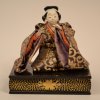 |
Hinaningyo Musician Doll |
This hinaningyō doll is part of a Hinamatsuri (Girls' Day or Doll Festival) set of dolls. The doll is one of the five gonin bayashi, or musicians. He is sitting in a position to play the flute, which is now missing. He is wearing a purple and gold brocade outer kimono... |
AB 1055 w |
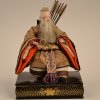 |
Hinaningyo Doll |
This court guard figure is part of a Hinamatsuri (Girls' Day or Doll Festival) set of dolls; it would be positioned on the fifth tier in a traditional arrangement. The doll represents the army and is dressed in a gold brocade kimono with red-lined sleeves, wears his gray hair tied in a... |
AB 1055 y |
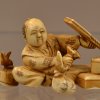 |
Netsuke |
This miniature ivory netsuke features a man seated cross-legged and holding a battledore (hagoita) in his left hand (he may hold a shuttlecock in his right hand). He wears a kimono with plant and cross-hatched decorations. There are several other objects strewn about... |
AB 1057 |
 |
Geta |
This pair of wooden geta, or sandals, are stained with a red-brown color and feature a carved grain design called "kamakura-bori." Kamakura-bori is a style of wood carving in which the artist first carves an image, then coats it in colored lacquer and polishes it. The... |
AB 1076 |
|
|
Toy Dogs |
This folk art figurine features two dogs. The bodies are made from papier-mâché. The large dog is an inuhariko; it is painted white with black spots and wears a fabric vest that has been glued on. The inuhariko also has a red fabric collar tied around its neck. The other dog... |
AB 1101 a |
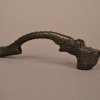 |
Yatate (Brush Holder) |
This single-piece bronze yatate, or brush and ink holder, is curved like a bow. The brush is missing, but when in place would have completed the bow shape. This creative shape (most yatate are pipe-shaped) indicates that this piece likely dates to the late Edo period (1600-... |
AB 1106 f |
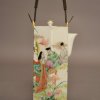 |
Pot |
This tall, hexagonal ceramic pot is meant to hold soy sauce. The handle is made of coiled metal hooked onto the pot, and there is a bent stick inside the coil as boning. The underside of the lid has six kanji characters painted in blue ink. The exterior of the pot features a spring... |
AB 1107 a,b |
 |
Hinaningyo Doll |
This female lady-in-waiting doll is part of a Hinamatsuri (Doll Festival or Girls' Day) set. She has a white composition face and black hair pulled back into long ponytail. Her hair falls down her back to the end of her trousers and is tied at the back of her neck and at intervals down the... |
AB 1130 m |
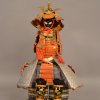 |
Miniature Suit of Armor |
This miniature samurai suit of armor is part of a Tango no Sekku (Boys' Day; now Kodomo no Hi, Children's Day) festival set. The suit of armor consists of seven pieces: the helmet (kabuto), mask, upper body armor, apron, leggings, shoes, and wooden stand. The helmet is made of... |
AB 1131 b |
 |
Miniature Katana & Shoto |
This set of two miniature swords (a katana and a shoto) and sword stand is part of a Tango no Sekku (Boys' Day; now Kodomo no Hi, Children's Day) festival set. The longer sword (katana) is positioned on the top rack, while the shoto (shorter sword) is on the... |
AB 1131 d |
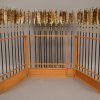 |
Arrows and Stand |
This set of two wooden stands and 32 arrow shafts is part of a Tango no Sekku (Boys' Day; now Kodomo no Hi, Children's Day) decorative festival set. Each stand holds 16 arrows (ya) and is hinged, holding nine arrows on one side and seven on the other. The arrow shafts are black with a... |
AB 1131 j |
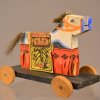 |
Horse Pull Toy |
This toy wooden horse is mounted on a four-wheeled black base. The horse is painted white with black spots outlined in blue, and has a blue snout and tan bridle. There are yellow and red paper decorations, each with black patterns. The mane and tail are made of real horse hair. |
AB 20 s2 |
|
|
Netsuke |
This lacquered wooden netsuke features a pair of komainu, or lion dogs, that are coiled together, one guarding a sacred jewel between its paws. According to customary depictions of komainu, one of the pair has an open mouth and the other a closed mouth, though both... |
AB 211.1 |
|
|
Netsuke |
This carved ivory netsuke represents a samurai riding a horse and accompanied by three other figures. The samurai carries a sword and a purse with green buttons. The horse, covered in a delicately patterned cloth featuring two Japanese characters (on the right side "... |
AB 220 |
|
|
Netsuke |
This small ivory netsuke features three figures wearing patterned kimono on a platform with large leaves. One of the figures, standing at the rear on the right side, is carrying a basket on the end of pole. Another figure, standing on the left side, is an anthropomorphic... |
AB 223 |
|
|
Netsuke |
This small netsuke depicts Jurōjin, the God of Longevity from the Daoist Seven Gods of Fortune, sitting on the back of a spotted deer. Jurōjin has his characteristically enlarged, bald head with swollen earlobes and a long beard; he holds open the scroll on... |
AB 226 |
 |
Netsuke |
This small ivory netsuke represents a man in a loincloth, kneeling on one knee and holding a block, with a mouse on his back. The man's head is turned to the right, his mouth open and his eyebrows raised, and his ribs are showing in his back and muscles in his arms. The mouse is... |
AB 228 |
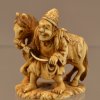 |
Netsuke |
This small ivory netsuke represents a man wearing a conical hat and leading a horse by a rope. The man's posture is hunched. They are both standing on a platform carved to look like the ground. The horse is wearing a patterned blanket and a bridle. |
AB 230 |
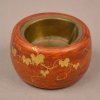 |
Hibachi |
This small round hibachi (brazier) is made of polished wood on the outside, with a metal bowl inset. The exterior is decorated with a pattern of grape leaves on a vine in gold. This hibachi may either be a miniature model or simply a small unit for ash and charcoal by which to... |
AB 27 |
 |
Samurai Doll |
This doll represents a seated samurai or officer, whose face is painted whitish pink and has glass inset eyes and hair tied up at the top of his head. The doll's facial features are painted, including downturned lips and up-pointed eyebrows. The doll's arms are bent in front at chest... |
AB 274 |
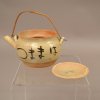 |
Teapot |
This small teapot has a grayish-green glaze on red clay, which is still visible in the unglazed interior. The teapot is decorated with calligraphy, reading Hamamatsu (the name of a city in Shizuoka Prefecture), in kanji characters on one side and in hiragana on the other side... |
AB 281 a,b |
|
|
Torii |
This small torii, or Shinto gate, is painted the traditional vermilion red. The top is slightly curved and is painted black. Each leg of the pole structure is connected to a square-shaped base, also made of wood and painted black. In the Shinto religion, which is indigenous to... |
AB 298 |
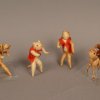 |
Miniature Samurai Animals |
This set of four miniature anthropomorphized samurai animals was likely meant for display, rather than for play. (a) is a miniature samurai boar, made of stuffed white cotton covered with a layer of brown that is flaking off. The boar is dressed in a red and gray woven... |
AB 32 a-d |
|
|
Netsuke |
This netsuke features several miniature masks carved from ivory. The seven masks, connected to each other somewhat haphazardly, represent oni (demons): some have horns and fangs, for example, while most of them have somewhat grotesque expressions and features. Some of the... |
AB 36 d |
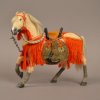 |
Samurai Horse |
This figure of a war horse was likely intended for a Tango no Sekku (Boys' Day, now called Kodomo no Hi, Children's Day) festival display. The horse is white with a red silk fringe apron, a floral brocade blanket, black and red lacquered stirrups (one is missing), a red bridle, and purple-and-... |
AB 360 |
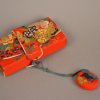 |
Purse |
This envelope-shaped pocket is a New Year's accessory for a young girl, and would be carried tucked into the obi (sash). The purse is made of red felt-like wool material, very lavishly embroidered with flowers in white, yellow, green, purple, and gold. The purse has a matching band,... |
AB 456 |
 |
Zori |
This is a pair of women's outdoor summer sandals, or zori. The zori are made of straw with dark rubber soles, and have v-shaped thonged straps with a striped pattern. The sandals have a floral pattern in faded turquoise and lavender embroidered on the top and symbols of pine,... |
AB 55-14 s2 |
 |
Sake Cup |
This small ceramic sake cup is a light cream color (perhaps faded due to age), with a central image of a brown sword or stick lying behind two gray, cloud-like structures with blue cords at either end. A small green half of a yin and yang symbol lies to the bottom right of the sword. There are... |
AB 55-1650 |
 |
Tea Caddy |
This metal tea canister, or tea caddy, still holds some tea inside. The tea caddy is decorated with an image of a boat on a river with trees on one side and Mt. Fuji in the background. The decoration is mainly in gold and silver but features some other colors. There is a large, thumbprint-... |
AB 55-19 s8 |
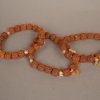 |
Juzu Prayer Beads |
This set of three Buddhist prayer or rosary beads (called "juzu" in Japanese) features beads of both glass and seeds. Each strand has three clear glass beads. One strand (AB 55-24 a) has a total of 19 seed beads, while AB 55-24 b has 17 and AB 55-24 c has 18. On each strand, the glass... |
AB 55-24 a-c |
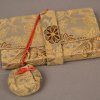 |
Purse |
This is a silk case or purse, which is folded with a matching band. It has a brown, grey, and tan brocade pattern, and red cord attaches it to a miniature scent pouch. There are two compartments in the main pouch. This purse may have been a wedding ornament. |
AB 55-36 |
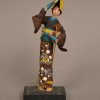 |
Doll |
This small doll, representing a woman in a kimono holding a shamisen, is made almost entirely from silk moth cocoons, with some bamboo possibly used on the shamisen and at the neck for support. The woman's kimono is purple with a floral pattern of flowers and... |
AB 56-2 |
 |
Wagasa (Parasol) |
This wagasa is made of hand-painted silk on a bamboo frame. The silk is a sheer teal color and features an image of a sakura (cherry blossom) branch with open blossoms and young red leaves. The outer ribbing is painted black and has a highly decorative kagari-ito (the... |
AB 56-30 b |
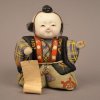 |
Yamabushi Doll |
This figurine of a yamabushi (mountain priest) is made of composition (heads, hands, and feet) and cloth (rest of the body). Yamabushi are mountain hermits, believed to have supernatural powers. The figure is bald with side whiskers and wears the small black cap... |
AB 56-4 c |
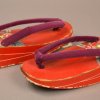 |
Zori |
This pair of zori (sandals) would have been worn by a young woman. They are made of red lacquered wood, and both shoes are somewhat chipped. Pink lines are painted on the sides; a floral design in pink, green, gold, and blue is painted on top of each sandal. The design is mirrored on... |
AB 56-6 |
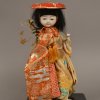 |
Fuji Musume Doll |
This female doll is named Fuji-Musume, the "Wisteria Maiden," and represents a popular character from kabuki theater. Dating from the 1950s, the doll wears a yellow kimono with a blue, white, and green floral pattern, and an orange and gold embroidered silk obi... |
AB 57-1 |
 |
Shuttlecocks |
These shuttlecocks are for use with a hagoita to play hanetsuki. They have gray beads with feathers attached to them and resemble flowers: one has pink and white feathers with a yellow center, the other has white feathers with an orange center. A shuttlecock (... |
AB 57-8 b |
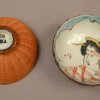 |
Sake Cup |
This sake cup, or guinomi, is made of porcelain with a woven exterior. The interior is painted with the head of a court lady in the Emperor's household, inside a scalloped aqua border. The court lady wears a red and white kimono and has yellow hair ornaments. The woven... |
AB 58-12 |
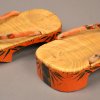 |
Geta |
This is a pair of child's geta (sandals). They have an orange lacquered wood outsole with a black and gold design of leaves and a thick black vertical stripe on the heel. The insoles are made of rice straw, and thonged straps in a v-shape are black and orange fabric with a diamond... |
AB 58-6 |
 |
Model of the Cloisonné Process |
This set of 12 rectangular tiles with rounded corners shows the process of cloisonné. The final design consists of two branches of wisteria (one white, one purple) and leaves with a single orange-colored blossom. The tiles are placed in a wooden case, each within a designated slot. Twelve steps... |
AB 589 a-m |
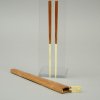 |
Chopsticks |
This hashi setto, or chopsticks (ohashi) and case set, features a pair of bamboo chopsticks with ivory tips. The chopsticks are a rectangular shape at the top and taper to a point at the bottom. They are stained dark brown. The case is made of bamboo with an ivory cap. A long... |
AB 59-12 a, b |
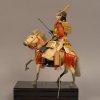 |
Samurai Doll |
This warrior doll, depicting the famous warrior Minamoto no Yoshiie, is part of a Tango no Sekku (Boys' Day; now Kodomo no Hi, Girls' Day) festival set. The samurai sits mounted on a white horse on a black stand. The samurai is dressed in full armor, a red and gold brocaded... |
AB 59-5 |
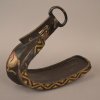 |
Stirrup |
This stirrup was originally part of a pair of lacquered wooden stirrups for a samurai's horse. The stirrup is painted with gold ornamentation and has a metal ring at the top to attach to the stirrup leather or strap. Samurai mounts were often heavily armored, with embellished... |
AB 60-10 b |
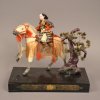 |
Samurai Doll |
This doll, likely intended for display during Kodomo no Hi (Children's Day, originally Boys' Day), represents a samurai warrior on a white horse. The figure stands on a black laquered wood base with a painted gold floral motif on the front. The samurai is dressed in full armor... |
AB 60-11 |
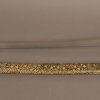 |
Katana Sword |
This samurai sword, or katana, has a handle with an inset of ray skin, and at one point had a cord braid attached. The blade itself has a small kissaki (point), and a faint, irregular yakiba pattern, or tempered surface along the blade edge. The sword guard (tsuba... |
AB 60-2 c |
 |
Shoto Sword |
This short samurai sword, or shoto, has a handle covered with ray skin and a fraying black braid. A decorative metal lion is attached to the side of the handle over the braid, and there are embossed dragons on the top of the handle and on the bottom rim where... |
AB 60-2 e |
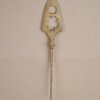 |
Arrowhead |
This arrowhead tip (yajiri) is made of steel and is a triangular shape with two cutouts on the tip. The top cutout is circular and the bottom is of a sakura (cherry blossom). It has a short handle to insert into the arrow shaft. It is one of a set of five yajiri.... |
AB 60-4 g |
|
|
Samurai Armor |
This lacquered and gold-leaf suit of samurai armor with red cording includes: breast- and backplates with panel apron attached; six panels hung from the waist; needlepoint shoulder padding under shoulder straps; two panels between the waist and the knee; a two-toned blue brocade and... |
AB 61-1 |
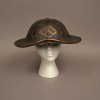 |
Kabuto |
This helmet, or kabuto, would have been worn by a Japanese foot soldier samurai. The helmet is shallow crowned with a flared brim and is carved from wood. It has a dull finished exterior on which Japanese characters have been carved and painted in gold around the band. A... |
AB 61-2 |
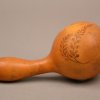 |
Gourd Sake Bottle |
This sake bottle is made from a hollowed gourd. It is rattle-shaped with a wide, round bottom and a long, narrow neck. There is a fern-like drawing on one side in ink, which has been outlined fully but not entirely colored in. There is no stopper. The bottle is made from "Lagenaria siceraria... |
AB 61-4 s1 |
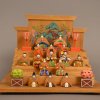 |
Miniature Hinaningyo Set |
This miniature Japanese Hinamatsuri (Girls' Day or Doll Festival) set is made of wood carved in a traditional style from Nara, Japan. The set has a wooden base with a four-tier staircase (t) and a wooden background featuring a painted pine tree design (u). Fifteen wooden figures, each with... |
AB 62-1 a-u |
 |
Geisha Doll |
This doll represents a geisha. Her body is made of painted silk over composition. Her facial features (eyebrows, eyelids, flushed cheeks, and red lips) are painted, dyed and molded. Silk ear lobes show under her black hair and her eyelashes are set in. The doll's black hair is worn in... |
AB 62-2 s4 |
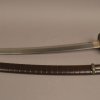 |
Katana Sword |
This samurai sword, called a katana, has a handle covered in ray skin, then wrapped in a braided fabric. The tsuba (sword guard) is made of wood and features a gold inlaid moon on one side and a metal bird attached to the other side among carved flowers. The scabbard... |
AB 625 |
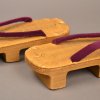 |
Geta |
This pair of wooden geta (sandals) have straw-covered soles. The wood used may be Paulownia wood, or "kiri" in Japanese. The straps are made of purple velvet and are replacements from roughly the 1960s for older greenish-brown straps. The undersides have a small metal fixture... |
AB 626 |
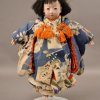 |
Ichimatsu Ningyo Doll |
This doll, named O-hana-san, is an ichimatsu ningyo, a doll meant for play rather than for display. The doll's face and body parts are painted ceramic. She has short, chin-length hair, glass eyes, and an open mouth showing teeth that are just coming in. She is made to look... |
AB 658 a |
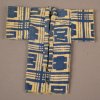 |
Miniature Kimono |
This miniature kimono is part of a miniature laundry set or drying yard. The kimono is made of a coarse woven fabric with a blue and white design. The seven-piece set originally included a drying rack, wooden bucket, floor stand, tub, and scrubbing board. |
AB 659 e |
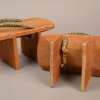 |
Geta |
This pair of wooden geta, or traditional Japanese footwear, features dark green cloth straps. The straps have a tan pattern of hexagons with four dots inside. These geta are quite high and would have protected the wearer from rain or snow. Geta are a form of... |
AB 66-15 |
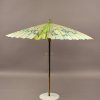 |
Wagasa (Parasol) |
This wagasa is made of thick washi paper on a bamboo frame. The washi has a light blue-green wash decorated with two types of flower blossoms, butterflies, and silver dots. There is no inner washi layer and the washi is uncoated, therefore it was... |
AB 66-16 |
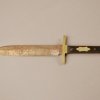 |
Kaiken Dagger |
This kaiken, or dagger, is sharp on one edge and has a wood handle with a bone inlay. There are three nails on each side of the handle joining the wood to the blade, which is fairly rusted with age. A kaiken is an 8-10 inch long, single or double bladed dagger without... |
AB 66-19 |
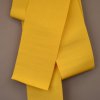 |
Obi |
This yellow woven, synthetic satin fabric obi is an example of a han-haba obi or half-width obi, a more informal sash that is worn casually with summer yukata. This obi is sewn over a stiff lining. The han-haba obi is very popular in Japan... |
AB 66-5 a |
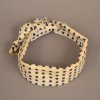 |
Tenugui |
This white cotton head scarf with a pattern of blue dots and smaller blue dashes is called a tenugui. Tenugui cloths were sometimes used around the house, but were often worn (by men) tied around the head. A tenugui like this one would have been worn at an Obon... |
AB 67-26 |
 |
Wagasa (Parasol) |
This wagasa (parasol) is made of painted silk on a bamboo frame. The parasol can be held closed by an orange decorative knot clasp with a tassle. The handle is made of bamboo with a decorative bulb at the end. It has a white decorative weave of strings that is tied onto the inside... |
AB 69-4 |
 |
Gosho-guruma |
This gosho-guruma, or ox-drawn carriage, is part of a set of figures for a Hinamatsuri (Girls' Day or Doll Festival) display. The two-wheeled cart is made of black lacquer with gold designs (including peonies, peaches, and fans); it has red window shutters with tassels and a ladder... |
AB 70-3 v |
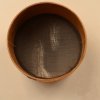 |
Sieve |
This round sieve has a woven horsehair bottom and sides made out of bark. Large and small sieves of this type were made in the home. The horsehair was woven to make the sieve through which teas and fruit juices or vegetables were strained. |
AB 727 |
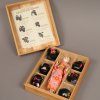 |
Hairdressing Doll |
This doll, named The Hanako, has six wigs in different hairstyles, all stored in a blond wooden box with seven compartments(for the doll and for her six wigs). The composition doll has a bald head, and is dressed in a pink flowered kimono. Her head is painted white and she has glass... |
AB 73-1 |
 |
The Tongue-Cut Sparrow Dolls |
This set of two dolls tells the story of "The Tongue-Cut Sparrow," a traditional Japanese folktale. The first figure (a) represents the old man from the story, whose humility is rewarded by the second figure (b), the Lady Tongue-Cut Sparrow. They both appear to be made of a composition-like... |
AB 739 a,b |
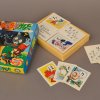 |
Riddle Card Game |
This card game of "Riddle Cards" (Nazonazo Karuta) comes in a colorful cardboard box. The box is filled with cards that have pictures or characters on one side and are blank on the other. The exterior of the box shows a bear wearing a mortarboard cap, green overalls, and a red bow tie... |
AB 75-16 |
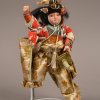 |
Kintaro Doll |
This Kintaro warrior doll is part of a Kodomo no Hi (Children's Day; formerly Tango no Sekku, Boys' Day) festival set. His composition face is painted pink and he has glass inset eyes. Kintaro wears a painted black headdress with white paper and floral decorations, a red jacket, and gold and... |
AB 75-2 |
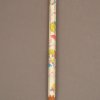 |
Pencil |
This pencil (or "enpitsu" in Japanese) is made for children and features cartoon-like designs of a blonde girl with blue and red flowers in her hair. Her face is repeated amid other red and pink flowers on a white background around the whole pencil. It is one of a set of four pencils... |
AB 75-8 a |
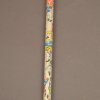 |
Pencil |
This pencil (or "enpitsu" in Japanese) is made for children and features football players in jerseys of various colors. The words "American Football" appear at the top in English. It is one of a set of four pencils in two patterns, purchased from the children's book department of a... |
AB 75-9 a |
 |
Battledore (Hagoita) |
This small wooden hagoita (battledore) features a painted design on one face; the reverse is unpainted. Unlike most hagoita, this one is flat and does not have three-dimensional fabric sculptural detailing on the front. The painting depicts a bust portrait of a girl, her eyes... |
AB 753 |
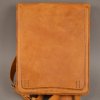 |
Book Bag |
This small rectangular leather book bag is part of a collection of items that would have been used by a 6th grade schoolgirl in Japan. |
AB 756 a |
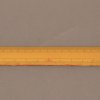 |
Ruler |
This yellow wooden ruler features one side with demarcations for 30 centimeters and unmarked demarcations of a different size on the other side. The ruler is part of a collection of items that would have been used by a 6th grade schoolgirl in Japan. |
AB 756 d |
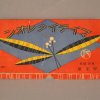 |
Crayons |
This thin, rectangular Japanese crayon box is part of a collection of items that would have been used by a 6th grade schoolgirl in Japan. The box features the words "Maitei Kureon" ("Mighty Crayons") in katakana across the front and again underneath the top lid. A modern,... |
AB 756 k |
 |
Collected Gems of Japanese Children's Stories |
This book, in two volumes, is titled Collected Gems of Japanese Children's Stories. The books are part of a collection of items that would have been used by a 6th grade schoolgirl in Japan. The books are rather large, hardback volumes with their own cases (one case is now... |
AB 756 t |
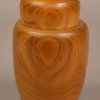 |
Tea Caddy |
This wooden tea canister is in the shape of an urn. It has a small inner lid and a large outer lid, and is intended for storing tea in the home. The Japanese word for tea is o-cha. Tea is served in cups without handles and without milk, sugar, or lemon. A very small teapot is... |
AB 76-101 |
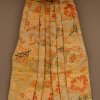 |
Hakama |
This pair of men's hakama (pants) was meant to be worn during a theatrical performance such as Nō. They have straps for tying at the waist and are decorated with floral and drum designs that are scattered over a tan silk ground, embellished with gold, teal, orange, and black... |
AB 76-103 |
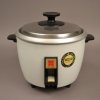 |
Rice Cooker |
This white rice cooker is circular, with black plastic handles. It has a metal top with one circular plastic black handle. The pot stands on three pegs. The front has a white switch, which is used to heat the rice. Below the switch is an outlet, where the cord plugs in. Next to the switch is a... |
AB 76-109 |
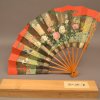 |
Sensu |
This is a handheld paper folding fan, called a sensu. The skeleton is made of wood; the exposed wood over the paper at each end has designs carved into it. The fan is decorated with a floral scene over a red and gold background. The images differ on each side, but many of the same... |
AB 76-110 |
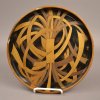 |
Tray |
This circular serving tray is made of black lacquer with a curvilinear design in gold and bronze. The design is on both sides of the tray. It was donated to the Boston Children's Museum by Mr. Masatako Yamaguchi of the Citizens of Kyoto, Japan in 1976 to honor of the Boston... |
AB 76-111 |
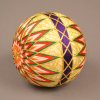 |
Temari Ball |
This traditional ball is filled with small objects to create noise when shaken and is used in the game temari. It is decorated with geometric patterns in red, orange, purple, white, and gold silk thread. Two identical flloral designs are on either side, with a purple stripe down across... |
AB 76-114 |
 |
Shinto Amulets |
This pair of small carved wooden Shinto amulets or charms is intended to ward off evil. The amulets are each shaped like a round human face with hair and other features carved in, and are attached to blue cords. There are Japanese characters in green and red on the backs of the amulets. The... |
AB 76-115 and AB 76-116 |
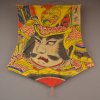 |
Sagara Kite |
This painted paper Sagara kite depicts a bust portrait of a mythological warrior. He is wearing yellow and red armor, and his helmet (kabuto) features a dragon at the helm. The fletches of an arrow are visible at the upper left, and an inscription in kanji script is on the... |
AB 76-117 |
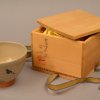 |
Chawan (Tea Bowl) |
This glazed pottery chawan, or tea bowl, is stored in a plain wood box with black ink kanji characters and a signature in red ink. The lid is slightly warped, and a blue-and-orange cloth ribbon is attached for closure. There is yellow cloth inside for packing. The chawan... |
AB 76-120 |
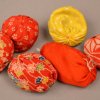 |
Otedama |
These five otedama, or silk bags filled with rice, are part of a game. There are four red and white beanbags and one yellow. The game is played by tossing the yellow beanbag into the air and picking up the other bags before it lands, in a manner similar to "jacks." They were... |
AB 76-127 |
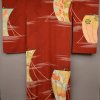 |
Kimono |
This kimono is a deep brick red, patterned with pale blue, orange, and white sail boats. It has a red lining. The silk is woven with a flying geese and wave motif. Red linings fell out of use in the 1950s, so this kimono predates that time. The kimono is a... |
AB 76-132 |
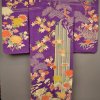 |
Kimono |
This kimono is made from purple silk and features red, orange, yellow, green, and white chrysanthemums and clouds. It has a red lining, and there are bamboo, cherry blossoms, and other flowers woven into the silk. Red linings fell out of use in the 1950s, so this kimono ... |
AB 76-133 |
 |
Obi |
An obi is a sash for a kimono, traditional Japanese dress. There are many types of obi, which are categorized by their design, material, and use. A tsuke obi, or ready-tied obi, is typically much shorter than other types of obi. With... |
AB 76-138 |
 |
Zaru-Soba Tray |
This tray for serving soba noodles is made of two pieces: a bamboo frame and mat. The mat is made of thin slices of bamboo about 1/8" wide that are joined together by roping in three locations: one in the middle and two that are equally spaced out on either side. The frame is held... |
AB 76-145 a,b |
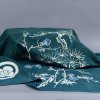 |
Furoshiki |
This furoshiki, or wrapping cloth, is made of a dark green-dyed fabric. It consists of three long panels joined at two seams. The design features the "three friends of winter" (bamboo, plum, and pine trees) and a large mon (family crest) at a bottom corner, here a four-petal... |
AB 76-48 |
 |
Wedding Kimono |
This uchikake, or wedding kimono, is made of an off-white colored silk that is hand-embroidered with a sakura (cherry blossom) design in red, teal, gold, blue, and white. It has a red lining. The kimono is a Japanese traditional garment. Kimono... |
AB 76-53 |
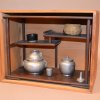 |
Tea Ceremony Set |
This tea set would have been used for a Japanese tea ceremony. The items sit on a wooden three-tier shelf unit stained a dark brown color. This unit is enclosed by a lighter wooden case, which has a removable sliding shutter at the front. The shutter has Japanese characters written on it. The... |
AB 76-58 |
 |
Hanafuda Game |
This deck of cards, called Hanafuda cards, feature colored designs and are used in a matching/counting game. Each of the cards has a different brightly colored decoration, for example: a small orange deer under a tree with autumn leaves; a large white moon in a red sky over a dark hill... |
AB 76-67 |
 |
Purse |
This small purse or money pouch is made in the shape of a baby doll. The doll figure is in an outstretched position on its stomach, covered in green silk clothing with a geometric floral design and a pink, white, orange, and silver collar. The body of the doll makes up the purse. A brown velvet... |
AB 76-85 |
 |
Tabi |
This pair of tabi, or white cotton slippers, have a white cotton canvas sole. There are four metal and thread enclosures at the ankle, and the toe is split to fit around the thong of a traditional-type shoe (such as geta). Tabi are traditional Japanese ankle-... |
AB 77-17 |
|
|
Battledore (Hagoita) |
This hagoita (battledore or racket) is used to play the game of hanetsuki, which is similar to badminton. The design featured on this battledore is of a woman wearing a red kimono with a gold, white, and blue floral design. The left side of her kimono is gold with an... |
AB 77-4 a |
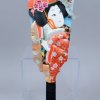 |
Battledore (Hagoita) |
This hagoita is used to play the game of hanetsuki during the New Year. On one side of the paddle is a three-dimensional figure of a woman wearing an embroidered kimono in red and gold with metallic embellishments. She wears a red hat and carries a branch of wisteria... |
AB 77-4 b |
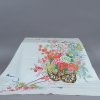 |
Furoshiki |
This furoshiki is made of a cream-colored fabric. A large, multicolored image seated at the lower right corner expands and fills much of the cloth, featuring a brown and gold wheelbarrow overflowing with flowers and leaves, representing the four seasons. There are peonies and wisteria... |
AB 77-6 |
 |
Container |
This small wooden bucket, only about six inches high, is a miniature version of a bucket meant to hold eels until they are ready to be cooked. The bucket has an arched handle attached to either side of the basin and a round, flat lid with two protrusions for a handle. |
AB 772 |
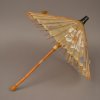 |
Higasa |
This higasa, or parasol, is one of the Miss Kyoto doll accessories. The parasol has a bamboo pole and ribbing, with a black atama rokuro (top cap) and a silk covering that has mostly deteriorated over time. The remaining silk is a neutral color (perhaps faded from white) with... |
AB 782 o |
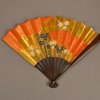 |
Sensu |
This sensu, or accordion-style folding fan, is one of the Miss Kyoto doll accessories. The miniature fan has wooden ribbing and a paper mount, painted with a scene of blue and white irises against a flowing gold and orange background. The painting is likely an allusion to the... |
AB 782 s |
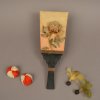 |
Battledore, Shuttlecocks, & Otedama |
This collection of toys is one of the Miss Kyoto doll accessories. The set includes a hagoita (battledore) and two shuttlecocks for use in the New Year's game hanetsuki, as well as two otedama bean bags. The hagoita (AB 782 u.1) has a black handle and... |
AB 782 u.1-5 |
|
|
Miss Kyoto Doll |
Miss Kyoto, on display in one of the "street windows" by The Japanese House, is a Friendship Doll and an example of the Ichimatsu Ningyo type of traditional Japanese doll. She has a composition head, legs, and arms, a stuffed body, and black hair. Her kimono is... |
AB 782.1 |
 |
Mirror and Case Accessories |
This mirror, case, and stand set are Miss Kyoto doll accessories. The set includes five pieces featuring a black lacquer background painted with a gold leaf and floral design. The mirror is made of metal (possibly bronze), with a bamboo-wrapped handle. The other pieces include a box with a lid... |
AB 782.10 |
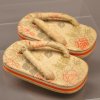 |
Zori |
This pair of formal zori sandals are Miss Kyoto doll accessories. The zori are covered with a cream-colored silk with a pattern of pale green and olive leaves and orange and green flowers. They have padded silk thongs covered in the same fabric. There are orange and white... |
AB 782.11 |
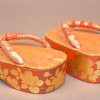 |
Geta |
This pair of geta are Miss Kyoto accessories. This distinctive style of geta is known as okobo (or pokkuri or koppori) because of the sound they make when walking. They are intended for very formal wear by young girls and geisha-in-training (... |
AB 782.12 |
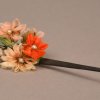 |
Hair Ornament |
This hairpin is one of the Miss Kyoto doll accessories. The ornament consists of an arrangement of silk flowers on a straight wooden pin. The flowers include four cream and brown flowers, one orange flower, and one orange and cream flower. There is a small pearl at the center of each flower... |
AB 782.13 |
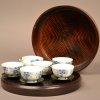 |
Tea Set & Bamboo Container |
This tea set (AB 782.14) is one of the Miss Kyoto doll accessories. The set includes five white porcelain tea cups with a blue floral design, five black metal saucers, and a matching blue and white porcelain dish for cooling water (that looks like a saucer). The water dish has no handles; it... |
AB 782.14 - AB 782.15 |
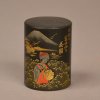 |
Tea Caddy |
This tea canister is one of the Miss Kyoto doll accessories. The tea caddy is made of tin, and has a body and a lid. The caddy is black and painted with an image in gold, red, and green of a woman picking tea, with a village and Mt. Fuji in the background. There is an inscription in Japanese... |
AB 782.17 |
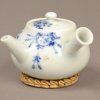 |
Teapot |
This teapot is one of the Miss Kyoto doll accessories. The teapot is made of white porcelain with blue flowers, and matches the teacups of AB 782.14. Its spout and handle are at right angles to each other; the handle is hollow. The set includes three pieces: the body of the teapot, a matching... |
AB 782.18 |
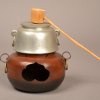 |
Hibachi Set for Tea |
This water kettle (hibachi) and bamboo water scoop set is one of the Miss Kyoto doll accessories. The set is a miniature of the kind of set used to heat water for tea during a tea ceremony. The metal hibachi (brazier) is round and brown, with a blackened incised base. There is... |
AB 782.19 |
 |
Toy Lamb |
This toy lamb is one of the Miss Kyoto doll accessories. It is made of stuffed white wool and has black eyes, an orange stitched mouth and nose, a curled tail, floppy ears, and splayed legs. The lamb wears a padded silk collar tied around its neck with a brass bell. |
AB 782.23 |
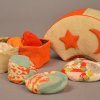 |
Otedama |
This otedama (game of bean bag toss) set is part of the Miss Kyoto doll accessories. The otedama bean bags are held in an orange and cream colored silk-covered, crescent-shaped box, decorated with an orange moon and star on the cover. The inside of the box is lined with blue... |
AB 782.24 |
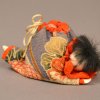 |
Doll Purse |
This purse is one of the Miss Kyoto doll accessories. The purse is in the shape of a baby doll, lying in an outstreched position on its stomach; at the top of the back is a drawstring opening. The doll has black hair, and short fabric arms and legs. The purse is covered in silk, featuring an... |
AB 782.25 |
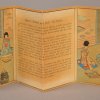 |
Tea Parties Booklet |
This booklet on tea parties is one of the Miss Kyoto doll accessories. The paper booklet is block printed in polychrome and folded accordian style into four panels. The cover features a pagoda peeking out from a cluster of sakura (cherry blossoms) and the title: "Japanese Children and... |
AB 782.28 |
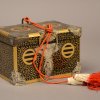 |
Doll Trunk |
This miniature lacquer trunk is a Miss Kyoto accessory. The trunk is covered in black lacquer that has been painted with a gold leaf design and circular shapes divided by two bars. Tin pieces cover the corners of the trunk and comprise the lock and hinge hardware. There is a faded red and gold... |
AB 782.5 |
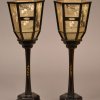 |
Bonbori Lamps |
This pair of miniature bonbori lamps is one of the Miss Kyoto doll accessories. They are both made of black lacquer with a painted gold leaf design on the base. The six-sided lampshades are made from separate pieces of silk painted with sakura (cherry blossoms). The lampshade... |
AB 782.6 and AB 782.7 |
 |
Miniature Sewing Chest |
This unusually shaped sewing chest is one of the Miss Kyoto doll accessories. The chest is made of black lacquer with a painted gold leaf and floral design. The square base has three layers of drawers: the bottom two drawers are as wide as the base, while the top layer is divided into two... |
AB 782.8 |
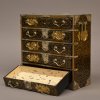 |
Miniature Chest |
This chest is one of the Miss Kyoto doll accessories. The chest is made of black lacquer painted with a gold leaf and floral design. The corners are covered in tin; the lock, handles, and hinge hardware are also made of tin. The chest has five drawers, each with a cream and gold glitter... |
AB 782.9 |
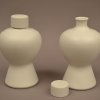 |
Wine Jar |
These two ceremonial sake jars are a pair. Both are white, unglazed porcelain, with a flared base, an urn-shaped body, and a narrow mouth with a cylindrical lid. This ceremonial stoneware was used for the opening ceremony, Shunko-shiki, of The Japanese House on October 14,... |
AB 79-2 a,b |
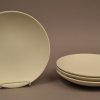 |
Offering Plate |
This is a set of four unglazed, ceremonial porcelain plates. They would have been used to hold fruit, lobster, rice, and salt as offerings to honor the land, sea, and mountains. This ceremonial stoneware was used for the opening ceremony, Shunko-shiki, of The Japanese House on... |
AB 79-2 c d e f |
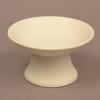 |
Offering Plate |
This white, unglazed porcelain ceremonial dish with a pedestal was used during the opening ceremony, Shunko-shiki, of The Japanese House on October 14, 1979. |
AB 79-2 q |
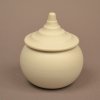 |
Ceremonial Bowl |
This white, unglazed porcelain bowl with a lid was used for ceremonial purposes during the opening ceremony, Shunko-shiki, of The Japanese House on October 14, 1979. |
AB 79-2 r |
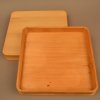 |
Ceremonial Tray |
This bentwood tray was one of four used during the opening ceremony, or Shunko-shiki, of The Japanese House in 1979. |
AB 79-3 a |
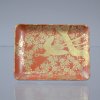 |
Lacquer Tray |
This small lacquer tray has rounded corners and slightly upturned sides. It has a red background with a gold design of a weeping sakura (cherry tree) and a pheasant in flight. The underside is a darker red with a gold speckle design. The tray is believed to have been either an ashtray... |
AB 798 |
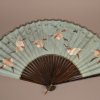 |
Sensu |
This late 19th-century Japanese sensu (folding accordion fan) has a guard and frame of black lacquered wood. The guards also feature small floral designs etched in red. The front of the paper mount features six birds (possibly sparrows) in flight against a blue background with black... |
AB 799 |
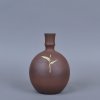 |
Vase |
This late 20th-century zogan-ware vase was made by the artist Masayuki Imai. It is a rounded, brown-colored vase with a narrow neck and opening. It features a cream-colored bamboo design outlined with fine lines cut into clay; a fan/kite motif is etched out in a similar manner on the... |
AB 80-14 |
 |
Tray |
This zara (tray) is made of a vermilion-red lacquer with images of pine needles in gold and green at the center. Pine needles represent resilience—they are one of the "three friends of winter," along with plum blossoms and bamboo, all of which grow during the winter in... |
AB 80-19 |
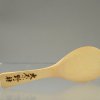 |
Rice Paddle |
This bamboo rice paddle (a), or shamoji, features the words "Oharano Jinja" (Oharano Shrine) in four kanji characters, burned onto the surface of the handle. It is accompanied by a paper bag (b), on which is written the words "Oharano Shrine" and "Fuku shakushi" ("... |
AB 80-30 a-b |
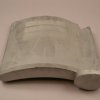 |
Kawara Roof Tile |
This kawara (roof tile) is one of the roof tiles were used for the reconstruction of the Japanese house. It is made of clay, formed in a curved rectangular shape appropriate for the eaves, with a decorative disc on one side. It is silver gray in color. This type of tile is for the... |
AB 80-34 |
 |
Kawara Roof Tile |
This kawara (roof tile) is one of the roof tiles were used for the reconstruction of the Japanese house. It is made of clay, formed in a curved dome shape embellished to resemble a face, and it is silver gray in color. The face has large eyebrows, circular blank eyes, bulging cheeks,... |
AB 80-37 |
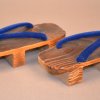 |
Geta |
This pair of wooden geta (sandals) have blue and yellow straps. The geta are traditional in form, but the straps are more modern. The wood is dark and has a particularly strong grain. Geta are a form of traditional Japanese footwear that resembles both clogs... |
AB 81-102 |
|
|
Kappa Mask |
This papier-mâché mask represents a kappa, one of the yokai (supernatural creatures) from Japanese folklore. It is recognized by its beak as well as the blue formation at the top; this would either be the container for water that is the source of a kappa's power, or... |
AB 81-122 |
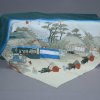 |
Furoshiki |
This furoshiki (wrapping cloth) is square in shape and features a village scene design on half of the surface, divided diagonally. The other half is a solid forest green color. The village scene appears to be from the Fifty-three Stations of the Tōkaidō print series made by... |
AB 81-128 |
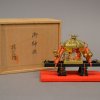 |
Miniature Omikoshi |
This miniature omikoshi, or portable Shinto shrine, comes with a wooden box and rests on a red fabric-covered platform. The bottom half of the omikoshi is black wood with two long beams tipped with gold, with gold handles on each end. Long beams are supported by two planks at... |
AB 81-130 |
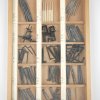 |
Nails |
This assortment of 15 different types of nails is set in a wooden display case. Labels identifying each type of nail run along the top of each compartment, and are written in both Japanese script and in rōmaji (the Latin alphabet). These nails were given to the Museum after the... |
AB 81-138 |
 |
Branding Iron |
This branding iron has the Japanese characters for "Kyo no Machiya" (Kyoto House) and a light wooden handle with a gold rim. The handle is connected to a long metal rod with the symbol welded onto the tip of the rod. |
AB 81-141 |
|
|
Kamidana |
This kamidana, or Shinto shrine, consists of three pieces: (a) the shrine itself, (b) the door piece, and (c) a plaque. It was originally in kitchen of The Japanese House. The kamidana is a small, wooden structure with two front doors that open out. Inside the shrine, there... |
AB 81-19 a-c |
 |
Incense Burner |
This blackened bronze kōro, or incense burner, features the komainu ("lion dog") on its lid. The komainu, also known as the shishi or jishi, is a creature typically seen at the gates of Shinto shrines and Buddhist temples. Komainu are... |
AB 81-2 d |
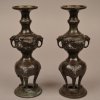 |
Candlesticks |
This set of two candlesticks is meant to go in a butsudan, or household Buddhist altar. Made of blackend bronze, the candlesticks have a narrow neck with a wide flute mouth. They have a figure eight shape below with two handles, with three legs on a round base, and bas relief... |
AB 81-2 e,f |
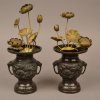 |
Altar Vases |
These blackened bronze vases with brass lotus blossoms were made to be part of a butsudan household altar. The vases have wide mouths, constricted necks, two handles, and a bas relief design. The several lotus blossoms are on individual stems that are soldered together and stick out... |
AB 81-2 g, h |
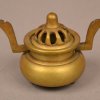 |
Ceremonial Bowl |
This small, smooth brass incense burner, called a kōro, was made to be part of a butsudan household altar. The pot features two winged handles and has a lid with a nob and several openings to let the smoke from the incense escape. A butsudan (literally "... |
AB 81-2 kk |
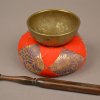 |
Altar Bell |
This brass bowl-shaped rin (bell) is meant to be part of a butsudan, or household Buddhist altar. The rin sits on a red cushion with purple and gold diamond-patterned decorations. The rin comes with a dark, wooden striker with a rounded head and a pinched... |
AB 81-2 n |
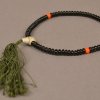 |
Prayer Beads |
This string of black Buddhist prayer beads, called juzu, are meant to be part of a butsudan household altar. The beads are likely made out of glass and the majority are black, but two red beads and the knot divide the strand into three sections. Tied at the knot is a green... |
AB 81-2 o |
|
|
Cloth, Altar |
This silk brocrade triangular cloth is meant to hang from a shelf in a butsudan, or household Buddhist altar. The altar cloth is embroidered with gold, black, and red thread on an ivory backing in a dragon motif. A butsudan (literally "Buddhist altar") is a shrine found... |
AB 81-2 q |
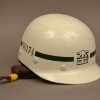 |
Hard Hat |
This plastic, vinyl hard hat was used by construction workers for the dismantling of The Japanese House in 1978 in Kyoto. The white hat has a brown cotton tie for securing at the chin. It is decorated with a green band and the kanji character "moku" ("woodworker") above the... |
AB 81-4 |
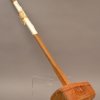 |
Carpenter's Mallet |
This wooden mallet has paper wrapped around the handle and a string of hemp tied on top of the paper. This mallet was used in the beginning of the reconstruction of The Japanese House for heavy work (joining main beams, structure posts, and the like). It was not used in finishing work, except... |
AB 81-40 |
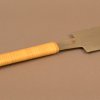 |
Saw |
This carpenter's saw, one of a set of five, is called a ryōba nokogiri in Japanese. Some of the saws in the set were used as back-up tools in the construction of The Japanese House in 1979. The saw has a flat, rectangular blade with small teeth on both sides and a wooden... |
AB 81-46 d |
 |
Carpenter's Plane |
This carpenter's wood and steel plane was used in the assembly of The Japanese House in 1979. |
AB 81-48 |
 |
Sharpening Stone |
This sharpening stone, or toishi, is made of dark gray, hard, rectangular carbon stone with metallic flecks. The label attached to the side of the stone reads: "A product by Carbon Stone, Hatahoshico, Ltd." The stone is possibly intended for use to sharpen other stones or to flatten.... |
AB 81-49 |
 |
Chisel |
This steel chisel with a wooden handle was one of a set of chisels either used in the construction of The Japanese House or as a presentation set in 1979. It has a sticker label with the manufacturer's information, a steel ring at the top of the handle, and another sticker label indicating its... |
AB 81-51 d |
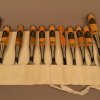 |
Tool Belt |
This white cotton canvas pouch is for storing a set of chisels. It has white cotton ties, reinforced with a leather tab. The pouch is part of a set of chisels either used in the assembly of The Japanese House or as a presentation set in 1979. |
AB 81-51 j |
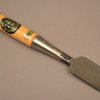 |
Chisel |
This steel chisel, one of a set, was either used in the assembly of The Japanese House or as a presentation set in 1979. It has a wooden handle, a paper label, and a steel ring at the top of the handle. |
AB 81-51 l |
 |
Carpenter's Square |
This steel framing square, one of a set of three, is L-shaped and flexible, with markings in green. It is used for conversion from shaku (a traditional Japanese unit of measurement) to the metric system. The framing square was used by carpenters during the construction of The Japanese... |
AB 81-59 a |
 |
Paint Spray Gun |
This brass spraygun is cylindrical in shape with a cone on top and a nozzle attached. A handle is attached to the side. The spraygun was invented by Dr. Koichi Yamada and produced by Kenji Nishikawa of Shikoku Kasei Co. Ltd. as a solution to how to achieve a "Kyoto style" wall effect in The... |
AB 81-60 |
 |
Hammer |
This wood and steel, hand-forged carpenter's hammer is one of a set of three that provide a representative sample of Japanese hammers. It was used in the construction of The Japanese House in 1979. The hammer has one flat face and one pointed end as well as a wooden handle with a manufacturer's... |
AB 81-62 c |
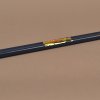 |
Crowbar |
This crowbar is made of steel and painted blue, and was used in the construction of The Japanese House in 1979. It has a "paw" at one end that is painted red, and a square blade at other end. The number 600 is stamped on the upper part, and there is a gold label with Japanese text identifying... |
AB 81-65 |
 |
Trowel |
This steel trowel with a wooden handle was used in the construction of The Japanese House in 1979. The handle is made of unfinished wood and has a black and gold sticker on it. The trowel has a short, straight, squarish shaft leading to the flat head; it was used for clay, cement, and plaster... |
AB 81-66 d |
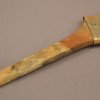 |
Brush |
This brush is one of a set of five wooden natural bristle brushes of varying sizes that was used by carpenters working on The Japanese House project in 1979. The widths of the brushes increase in size from (a) to (e), though (a) and (b) are the same. Each brush has an angled head, and the... |
AB 81-69 d |
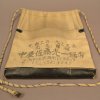 |
Nail Pouch |
This nail bag is made of white canvas and features black lettering. It has a drawstring to secure the bag around the waist, as well as a large, deep pocket and a smaller front pocket containing assorted nails. The text on the front is an advertisement for a nail shop with its phone number. The... |
AB 81-74 |
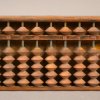 |
Abacus |
This soroban, or Japanese abacus, belonged to The Japanese House. The Japanese soroban differs from the Chinese abacus in that it only has one row of beads on top, resulting in a slightly different calculation system. The soroban is made of wood (frame and back),... |
AB 81-82 |
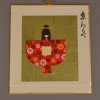 |
Warabe-ningyo |
This picture or wall hanging is a Hinamatsuri, Girls' Day or the Doll Festival, decoration. The wall hanging features a "Warabe-ningyo" ("young girl doll"), a type of kami-ningyo, or paper doll. The paper doll is three-dimensional and origami-folded; she consists of a red ... |
AB 81-93 a |
 |
Ogura Hyakunin Isshu Card Game |
This Japanese poetry card game, called "Ogura Hyakunin Isshu" ("100 poems by 100 famous poets") features 100 famous tanka poems written in Japanese. The box top has a colorful design of a man and a woman dressed in Heian period (794-1185) clothing. The woman is wearing a red,... |
AB 81-96 |
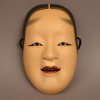 |
Ko-omote No Mask |
This is a hand-carved and -painted No theater mask of a young woman made by the artist Izan Hotta. It would have been worn by a male actor. Called a "Ko-omote" (literally, "little mask"), it is meant to portray a beautiful and innocent young girl under the age of twenty. The... |
AB 81-98 |
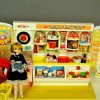 |
Licca-chan Doll & Supermarket |
This miniature toy supermarket comes with a Licca-chan doll, her blonde hair tied in a ponytail and dressed in a black maid's dress with apron and lace trim. The market has a yellow floor and yellow checkered walls covered with various advertisements. There is a pink cash register... |
AB 82-11 |
 |
Daruma |
This Daruma doll is made out of papier-mâché. It features the traditional pink face, black mustache and eyebrows, and gold markings on the red background. On the front center of the doll the kanji character "fuku" ("good fortune") is painted in gold. This doll was purchased at... |
AB 82-12 |
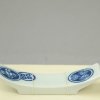 |
Chopsticks Rest |
This ceramic hashioki, or chopsticks rest, is boat-shaped with a design of three circular mon (family crests) in blue against a white background. |
AB 82-13 |
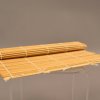 |
Makisu |
This makisu (bamboo mat) is used to roll the type of maki-zushi (sushi roll) with a layer of nori (roasted seaweed) filled with a layer of rice and a filling of vegetables or meat. The makisu is square-shaped, made of individual rounded bamboo sticks held... |
AB 82-18 |
 |
Teacup |
This blue teacup is made of glazed ceramic. It has a cylindrical shape that reinforces the bamboo design on the front. The bamboo stalk and leaves were carved away from the underglaze coat to reveal the raw white ceramic texture before the second firing. The underglaze has a beautiful indigo... |
AB 82-22 |
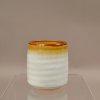 |
Teacup |
This ceramic teacup has a white/slightly blue-green colored glaze and a brown rim at the top and bottom. The surface has a ribbing effect, with eight rings. The cup widens gradually towards the base. |
AB 82-23 |
 |
Bento |
This bento lunch box has four separate parts: two rectangular containers for food with rounded corners, one loose piece of wood for separating types of food, and a lid. The box has a visible horizontal grain throughout. The bento is made of cedar (sugi in Japanese),... |
AB 82-27 |
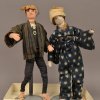 |
Minzoku Ningyo |
This pair of Minzoku ningyo (folk dolls), made by the fiber artist Sumako Cohn, represents a male and a female farmer dressed in traditonal garb. The male doll (AB 82-30) is wearing black trousers, zori (straw sandals), a green-and-blue striped top, an apron underneath and a... |
AB 82-30 and AB 82-31 |
 |
Shoe |
This pair of child's play shoes features characters from the anime "Saikyo Robo Daioja." The shoes have white canvas uppers with white rubber soles. The canvas uppers are covered in plastic decorated with the "Saikyo Robo Daioja" anime characters in bright colors. The soles... |
AB 82-33 |
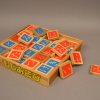 |
Mojiasobi Hiragana Game |
This set of 50 wooden blocks inside a wooden open box features the 46 hiragana characters. The kana (characters) are stenciled on one side of each block; a corresponding word and picture are painted on the reverse side. Four of the blocks are blank, one of which has a blue... |
AB 82-35 |
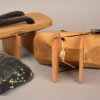 |
Geta |
This pair of tall wooden geta (sandals) have an attached rain protector of black painted canvas. The thonged straps were once tan but have been replaced with dark brown straps. A metal fixture on the toe of each shoe covers where the straps are tied. The rain protectors are attached... |
AB 821 b |
 |
Sake Cup |
This small ceramic sake cup, or guinomi, has a painted interior and a sculpted exterior. The interior features the face of Otafuku, the "homely woman," in black and gold against a white background. Otafuku, with her characteristic round cheeks, is a symbol of luck and good... |
AB 828 s1 |
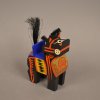 |
Miharu-goma |
This Miharu-goma horse toy is carved from a single block of wood. The horse is painted black, with a blue saddle and red and gold regalia. The tail and mane are attached palmetto. It is an example of the mingeihin (folk craft work) made by the inhabitants of Deko... |
AB 83-10 |
 |
Daruma Otoshi |
This Daruma Otoshi game is from Miyagi Prefecture in Japan. The game consists of a Daruma doll made of five cylindrical doughnut-shaped blocks, each a different color (red, yellow, green, purple, and unpainted) that make up the body and a painted headpiece on top. The blocks are held... |
AB 83-5 |
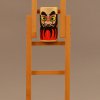 |
Daruma Game |
This Daruma game consists of a wooden ladder and a cylindrical Daruma doll (also made of wood). The ladder is stained dark and stands on a base, and has a hinged section to extend its heigh. The Daruma has two holes, just off center, with v-shaped slots open to each end of the cylinder. A... |
AB 83-7 |
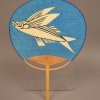 |
Uchiwa |
This uchiwa, or flat handheld fan, is made of bamboo and paper. The uchiwa features a design by the artist Keisuke Serizawa of a fish, based on the Okinawan stencil technique called bingata. The fish is white with black lines against a bright blue background. The... |
AB 83-8 |
 |
Ink Line |
This line marker, called a sumi-tsubo in Japanese, is made of a wooden wheel that holds a line of twisted linen. This linen is fed off the wheel into the well (the hollowed-out section of the body), which is filled with ink-soaked cotton. The linen, now covered with ink, is then drawn... |
AB 84-13 |
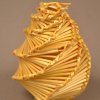 |
Firefly Cage |
This small firefly cage, or hotaru kago, is made of barley straw twisted into a spiral shape with a hole at the top and a braided handle. In Japan, children traditionally catch fireflies on the riverbanks in June. These types of cages are very traditional in form and used in the... |
AB 84-15 |
 |
Waraji Sandals |
This pair of waraji, or ice straw sandals, were made for a child by an artist named Keizaburo Imaizumi in Fukuoka Prefecture, Kyūshū, Japan. They were crafted in the traditional zori fashion, with red cloth woven in at the toes, at the middle of the shoes, and at the heels.... |
AB 84-17 |
 |
Chitose-ame Bag and Omamori |
This omamori (amulet) and paper bag packaging would have been used during the Shichigosan (7-5-3) Festival. (a) shows the packaging for chitose-ame, the "candy of a thousand years" that is given to children by a priest when they visit a Shinto shrine during the Shichigosan... |
AB 84-30 a-b |
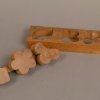 |
Rice Cake Mold |
This wooden rectangular rice cake (probably onigiri) mold is in two parts and features three designs: a miniature pine tree, a sakura (cherry blossom), and a fan. One of the mold pieces has these shapes in the negative, with the other part in the positive (with a handle), like... |
AB 845 |
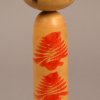 |
Kokeshi Doll |
This kokeshi doll is a traditional Japanese wooden doll consisting of only a head and a body. This particular doll is of the Tōgatta type. The body features a floral design depicting three chrysanthemums painted in red and a faint purple band around its shoulder and waist.... |
AB 85-14 |
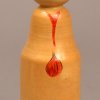 |
Kokeshi Doll |
This kokeshi doll, made by the artist Yonezo Sato (b. 1909) is a traditional Japanese wooden doll consisting of only a head and a body. This particular doll is of the Togatta type. The top portion of the body is a very thick bell shape with rounded shoulders; the bottom portion is... |
AB 85-23 |
 |
Kokeshi Doll |
This kokeshi doll is a traditional Japanese wooden doll consisting of only a head and a body. This particular doll, made by Chushichi Saito (b. 1917), is of the Tsuchiyu type: the body is thick and very stable. The branch from which the doll was made has been left uncarved... |
AB 85-26 |
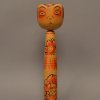 |
Kokeshi Doll |
This kokeshi doll is a traditional Japanese wooden doll consiting of only a head and a body. This particular doll is of the Nakanosawa group, a subset of the Tsuchiyu type. It features a long, thin body that is slightly convex and a very large head with a flat top.... |
AB 85-31 |
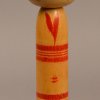 |
Kokeshi Doll |
This kokeshi doll is a traditional Japanese wooden doll consisting of only a body and a head. This particular doll, made by Tzutae Sato (b. 1906), is of the Yajiro type: it has a long, thin body and a large head that is wide at the top. The body has a faded yellow background... |
AB 85-33 |
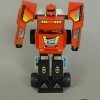 |
Transformers Toy |
This toy Transformers robot turns into a tow truck with a white cab, four large wheels, and a towing hook at the front. The truck is red with decals and transforms into a robot by pulling out the sides (doors and rear hubs), opening the hood, and pulling down the rear axle. The white cab is... |
AB 85-38 |
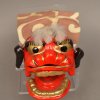 |
Yumijishi Mask |
This miniature shishi-gashira, or lion's mask, is called a yumijishi. The mask is painted wood, with a red background, gold eyes and teeth, and black ears and accents. There are white feathers attached to its head. There is a piece of purple and white cotton fabric attached to... |
AB 85-40 |
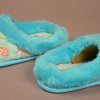 |
Slipper |
This pair of blue house slippers for children, size 18 cm, features a pattern of boys and girls in nightgowns holding moons, stars, and flowers. Among the children in the design are smaller purple stars, yellow moons, and pink bows as well. Blue synthetic fur lines the edges, and there is blue... |
AB 85-42 |
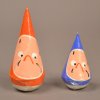 |
Sankaku Daruma |
This pair of "Sankaku Daruma (triangle Daruma)" dolls featurs an orange and a blue conical-shaped variation on the traditional Daruma doll. Each Daruma doll has a pink face painted on the front, with white eyes, an orange upside-down U-shaped mouth, and simplified black lines to... |
AB 85-43 and AB 85-44 |
 |
Take-ushi |
This toy bobble-head cow is known as a take-ushi (literally "bamboo cow"), and is painted black. A long piece of wood is attached to the back of the head; at the other end is the weight. The head is attached to the body by a cord. The cow is decorated with a red and white braided cord... |
AB 85-45 |
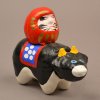 |
Daruma |
This papier-mâché figurine features a cow with a Daruma doll riding on its back. The cow is painted black with a white nose, belly, and legs. It has blue eyes, yellow horns, and a blue saddle with a red border and five white spots on each side. The cow is a bobblehead. The Daruma is painted in... |
AB 85-46 |
 |
Dragon Toy |
This papier-mâché dragon figurine has wheels. The dragon is painted green with black and gold scale designs down the back of the head and up the tail. Its face has light orange nostrils, a light orange mouth, white eyes outlined in black, and black detailing. There are two gold horns sprouting... |
AB 85-51 |
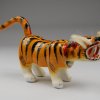 |
Hariko no Tora Tiger |
This papier-mâché bobblehead tiger, called a hariko no tora, consists of three pieces: the tiger's head, the standing tiger body, and the upraised tail affixed at the rear. The head is weighted in the neck area and hung on a metal wire inside the hollow neck of the body. The tiger's... |
AB 85-53 |
 |
Hime Daruma |
This Daruma doll is the Hime Daruma, or Princess Daruma. Made of papier-mâché, it is painted red with a gold diamond over the forehead and a white and green floral design painted on both sides and under the face. These plants are bamboo, plum blossoms, and pine, used for ceremonies... |
AB 85-54 |
 |
Netsuke |
This small ivory netsuke features two men and an oni (demon). One of the men is partially submerged in a round bathtub, his arms holding one side. The other man stands at the side of the bath, wearing shorts and grasping the edge of the tub with his right hand. He is holding a... |
AB 852 c |
|
|
Netsuke |
This small ivory netsuke may have functioned as the top for a perfume bottle. The carving represents three oni (demons) wearing patterned shorts. The oni on the left is bent over, holding a large cylindrical bowl. The oni in the middle is scratching his head... |
AB 852 s1 |
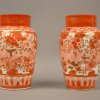 |
Pair of Vases |
This pair of similarly designed ceramic vases feature an orange-red color over a white background. The base tapers up slightly and narrows abruptly at the neck. A design featuring flowers, trees, and birds in a deeper orange color and gold leaf decorates the exterior. The potter, of the... |
AB 857 a,b |
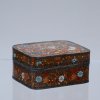 |
Cloisonné Box |
This cloisonné (shippō) square container with a lid features a chrysanthemum blossom pattern on the sides and a butterfly pattern on top. The interior has a blue lining. Cloisonné is a type of enamel in which wires are used to delineate decorative areas ("... |
AB 86 a,c |
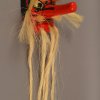 |
Tengu Mask |
This handpainted tengu (goblin) mask is made of papier-mâché and features the tengu's characteristic abnormally long nose. The eyebrows, mustache, and beard of the mask are made of sisal. The face is painted red with black and gold accents. Tengu masks... |
AB 86-1 |
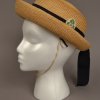 |
Hat |
This child's hat is made of woven straw and has a rounded brim. It is called a mugiwara bōshi in Japanese. A black ribbon hat band is tied in a bow in the back, and there is a small white and green felt disk with Japanese text on the left side. An elastic band for under... |
AB 86-4 |
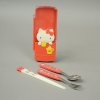 |
Chopsticks Set |
This portable hashi setto, or chopsticks and utensil set, includes a red plastic case with a design featuring Hello Kitty drinking from a yellow tea set on the cover. The case contains a stainless steel fork and spoon with red plastic handles decorated with Hello Kitty, a clock, a... |
AB 86-5 |
 |
Akabeko |
This large bobble-head toy cow is an example of an akabeko toy. It has a typical red body and features black, gold, and white highlights. The head is attached to the body with string. The cow carries a bunch of sisal (to represent rice) with a bell at the center as well as two wooden... |
AB 86-9 |
 |
Doll |
This girl doll has a composition head, glass eyes, and black, shoulder-length hair with bangs. Her eyelashes and lips are painted. She wears two (possibly even three) layers of clothing, perhaps made out of silk or cotton. If silk, her robe is a kimono; if cotton, she is wearing the... |
AB 868 a |
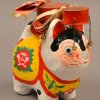 |
Inuhariko |
This papier-mâché toy dog is called an inuhariko. The dog has a red, drum-like noisemaker toy tied to its back. A paper and sisal noshi is tied to the top of the noisemaker. The noisemaker features the kanji characters that mean "happiness" on the top drum and the... |
AB 87-15 |
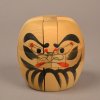 |
Daruma Puzzle |
This puzzle forms a variation on the Daruma doll when completed. The puzzle is natural wood color with the traditional angry Daruma face painted in black and red, featuring a thick black beard, eyebrows, markings under the eyes, and pupils. Thinner black strokes are used for the eyes, nose, and... |
AB 87-6 |
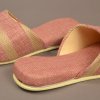 |
Slipper |
This pair of woven slippers features pink soles and pink-and-tan striped tops. They have an open back and a white bottom. In Japanese culture, people remove their shoes when entering homes and other buildings, especially where the floors may have rugs, polished wood floors, or tatami... |
AB 87-7 |
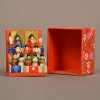 |
Miniature Hinaningyō Set |
This miniature Hinaningyō set is held in a miniature red box with a floral design on the exterior. The set, only 1 1/4" tall, is an abbreviated version of the traditional Hinamatsuri doll arrangement. It has a pull-out, three-tiered stand on which the ten tiny dolls are positioned. Decorative... |
AB 88-1 |
 |
Miniature Daruma Set |
This set of three miniature Daruma dolls are each about 1/2" x 1/2". They are painted red with pink faces, three black lines on either side of the face to represent facial hair and eyebrows, and six gold stripes on the front center. They each are wearing white tenugui (scarves) with... |
AB 88-12 a-c |
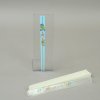 |
Chopsticks Set |
This ohashi setto (set of chopsticks) is for a child. The box has a sliding top; the chopsticks can be stored inside for transport to and from school. The chopsticks are made of wood, painted blue, and decorated with a boy and ghost and the logo "Obake no Q-Taro." The case is... |
AB 88-2 |
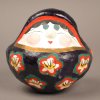 |
Hime Daruma |
This purple papier-mâché Hime Daruma (Princess Daruma) doll is made in the Mingei (folk art) style by an artist named Matsumoto. The doll features white five-petaled flowers outlined in red and green and with yellow centers with five black streaks pointed upwards from the... |
AB 88-6 |
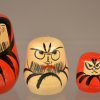 |
Nesting Daruma |
This Daruma doll is a wooden nesting doll consisting of four dolls in seven pieces. The largest Daruma is painted red with a natural wood-colored face. It has a beard and red mouth, a nose, scowling blue eyes, wrinkles and crows' feet, and red dot embellishments. A black arch is painted under... |
AB 88-9 |
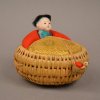 |
Izumeko Doll |
This izumeko, or baby doll in a basket, features a boy doll who is just chest and head underneath a gold brocade blanket and sitting on a red pillow. The blanket and pillow are tucked into a woven straw basket. A miniature izumeko made from an acorn nut shell is attached to... |
AB 89-10 |
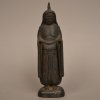 |
Kannon Maria |
This small, carved wooden figurine represents Kannon Maria: the Virgin Mary disguised as the bodhisattva Kannon, known as the Bodhisattva of Compassion. The statue comes from the island of Kyūshū, Japan, where Kakure Kirishitans ("hidden Christians") practiced their faith in secret, in... |
AB 89-4 |
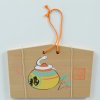 |
Ema |
This small wooden ema (votive plaque) is painted with a white snake wrapped around a yellow, red, and green top next to small plants. The plaque is from 1989, which was the Year of the Snake, thus most ema made during this time would also feature snake designs. The top... |
AB 89-9 |
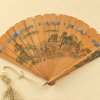 |
Sensu |
This sensu (folding fan) is made entirely of sandalwood. The fan is held together with blue ribbon (now detached). Each rib and guard are rounded at the top; a metal hook and pin hold the end of the handle together. A cream-colored tassel is tied onto the hook. The fan is... |
AB 890 |
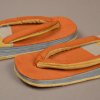 |
Zori |
This very formal pair of zori (sandals) are made of five layers of board covered in orange, blue, and gold silk. The thonged toe straps are orange and gold and attached in a v-shape. The top layer of the zori has a geometric design in orange, white, and gold. They would have... |
AB 895 s3 |
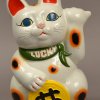 |
Manekineko |
This manekineko doubles as a ceramic sake bottle. The bottle takes the shape of a white bobtail cat with blue eyes, red ears, a pink nose and mouth, brown and orange spots, and a green scarf around the neck on which is placed a sticker that reads "lucky" in gold. The ... |
AB 90-1 |
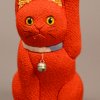 |
Red Silk Manekineko |
This manekineko is made of red silk, unlike the traditional ceramic versions. The cat has its left paw raised in a beckoning gesture, believed to bring good fortune to the owner. The glass eyes are yellow with black pupils, and the cat has an embroidered black nose, mouth, and whiskers... |
AB 90-3 |
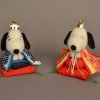 |
Snoopy Hinaningyō |
This set of two Snoopy dolls is for a Hinamatsuri (Girls' Day or Doll Festival) celebration. (a) refers to the Snoopy doll in blue, and (b) refers to the slightly larger Snoopy dog in red (possibly meant to be Snoopy's sister Belle). Belle is wearing a red, white, and yellow kimono ... |
AB 90-4 a,b |
 |
Manekineko |
This manekineko is made of gold-painted plaster with rhinestones that accentuate certain features. There are multicolored rhinestones on both inner ears, green rhinestones on the eyes, pink heart rhinestones on the collar, pink rhinestones on the claws, and a border of white... |
AB 90-5 |
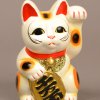 |
Manekineko |
This manekineko has a slit in the back of its head, possibly for a bank. The cat is white with black and orange spots and glitter around its red collar, on which hangs a bell. In its right paw, the manekineko is holding a gold coin with the words "Senman Ryō" (Ten Million Gold... |
AB 90-7 |
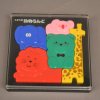 |
Animal School Supplies |
This desk set features school supplies in the shape of animals. They are all held in a black plastic case with a clear lid that has an inscription on the upper right-hand corner. The colorful animals inside include a blue elephant that doubles as a paper clip case (with two pink clips inside,... |
AB 90-8 |
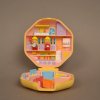 |
Angel Pocket |
This Angel Pocket toy features two miniature dolls in a compact yellow beauty salon. The toy is made of yellow, violet, white, red, pink, blue, and orange plastic. Both dolls are blonde-haired with brown eyes; the doll wearing a pink outfit has curly hair, while the one in a green outfit has... |
AB 91-13 |
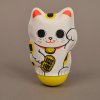 |
Inflatable Manekineko |
This inflatable manekineko, or "Beckoning Cat," is made of rubber and plastic. The yellow bottom is rounded and weighted so that the toy rocks back and forth when played with. The cat has a typical manekineko design: red inner ears, black and yellow patches on all four legs... |
AB 91-2 |
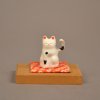 |
Miniature Manekineko |
This miniature manekineko (beckoning cat) is made of white plaster. The cat is painted with red ears and mouth and black spots and eyes. The cat is raising its left paw in a beckoning gesture, and is mounted on a square of red fabric with a white shibori (circle) design, which... |
AB 91-9 |
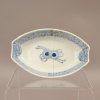 |
Sauce Dish |
This ceramic dish is meant to hold sauce, pickles, or condiments. It is boat-shaped and features a blue and white design of two mirrors with decorative knotting at the center and flowers on each concave end, as well as a patterned border. This dish was broken in half at one point but was sealed... |
AB 911 |
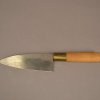 |
Kitchen Knife |
This kitchen knife is for cutting meat. It has a wooden, oval-shaped handle with a metal end nearest the blade. The blade, inserted into the end of the handle, tapers at one end. One side of the blade is polished while the other side has only a small polished strip, leaving the rest a black... |
AB 914 |
 |
Mennetsuke |
This small mennetsuke-style ivory netsuke features a mask of an old man's face. The man has a wrinkled brow and cheeks, and his mouth is laughing. He has a long mustache and a beard that curls up onto the reverse side of the mask. The artist's signature is on the back. This is... |
AB 925 s1 |
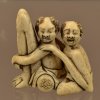 |
Netsuke |
This miniature ivory netsuke represents two older men who are partly bald. The men are seated one behind the other, one holding his abnormally long legs folded in front of him, and the other putting his abnormally long arms on the shoulders of the first. They are made of white ivory... |
AB 926 a |
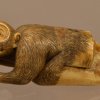 |
Netsuke |
This small ivory netsuke represents a monkey holding a garland of fruit. The monkey props itself up on its elbows and knees, leaning its head against the fruit. The top half of the netsuke is completed, but the bottom half is unfinished. |
AB 926 d |
|
|
Netsuke |
This miniature wood netsuke represents two figures. One is a bearded, grumpy-looking old man, half reclining with head on hand and wearing a floral patterned kimono. An open book lies beside him and two other books lie at his side by his foot. Standing behind him is an oni... |
AB 927 a |
 |
Tsuba |
This oval-shaped, slightly concave tsuba, or sword guard, is made out of ivory. The tsuba is carved in high relief with an image of the boy warrior Kintaro from Japanese folklore fighting a giant carp. The boy stabs the carp with a sword he holds in his right hand. The... |
AB 928 |
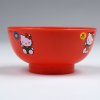 |
Rice Bowl |
This red plastic rice bowl features a "Hello Kitty" design. The bowl is decorated with three color decals of Hello Kitty, or "Kitty-chan" as she is known in Japan, and one color brand logo with a teddy bear. The bottom is stamped with the manufacturer's information (Sanrio Company).... |
AB 93-5 |
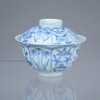 |
Futamono Bowl |
This porcelain bowl and lid is an example of a type of Japanese dishware called futamono, meaning "lidded dishes." Futamono are used to keep food warm. It has eight panels featuring four types of floral designs in blue; each panel is featured twice. Distinguishable are the... |
AB 936 a, b |
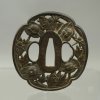 |
Tsuba |
This tsuba (sword guard) is made of iron and has four scalloped edges. In the center is a cutout design of peony blossoms and leaves, depicted from both sides on the front and the back. The long central cutout (called the nakago-ana) would hold the blade; the other two cutouts... |
AB 955 b |
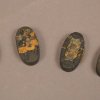 |
Sword Caps |
These four decorative metal caps are for sword hilts. They are oval and feature gilded relief designs. (b) features two old men (peasants) walking, one with a tea kettle over his shoulder, the other with some sort of tool (possible a hoe) carried over his shoulder. (c) features two faces: on... |
AB 965 b-e |
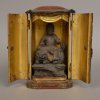 |
Buddhist Shrine |
This miniature religious shrine contains a statue of the Buddha, or possibly of the Bodhisattva Manjusri. The Buddha statue is made of a dark brown, carved wood. He is depicted seated on a lion, which in turn crouches upon a rock. The Buddha is seated in the "demon-subduing" posture, with his... |
AB 979 |
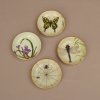 |
Sake Cup |
This set of four white ceramic-glazed sake cups (guinomi) takes the shape of wide-mouthed bowls and features flowers and insects. Each cup has a gold rim, but features a different design. One cup depicts a purple flower, either an iris or orchid. Another depicts a black and yellow... |
AB 989 s1 |
 |
Necklace |
This symmetrical necklace is made of beads carved from the horns of the sacred deer of Nara, Japan. The beads, of varying shapes and sizes, are a dark ivory color with carved circular geometric patterns. They are strung on a brown knotted cord with green jade beads interspersed. A club-shaped... |
AB 990b |
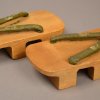 |
Geta |
This pair of wooden geta, or sandals, is made of keyaki wood from the zelkova tree. The thonged toe straps are made of leather, painted green with some patterning. Some of the paint from the toe straps has rubbed off on the wood. Geta are a form of traditional... |
AB 997 s1 |
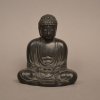 |
Miniature Buddha |
This small sculpture of a Buddha figure is a miniature reproduction of the Great Buddha statue at Kotoku-in temple in Kamakura, Japan, a colossal outdoor bronze sculpture of the Amida (Amitabha) Buddha. The Buddha is seated in a meditative posture, with his legs folded, and his hands folded in... |
AB XX 126 |
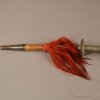 |
Mace |
This mace with the original spear point has a metal tip and a wooden shaft decorated with red-dyed horsehair. The tin handle has a hollowed bulb. The wooden shaft has many holes that appear to be a result of insects. The horsehair is tied on using a thin cotton cord dyed the same color red.... |
AB XX 133 |
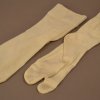 |
Tabi |
This pair of white nylon tabi covers would be worn over tabi socks to keep them clean. They are made like the socks, with a split toe that would allow them to be worn with geta or zori. Tabi are traditional Japanese ankle-height, split-toe... |
AB XX 164 |
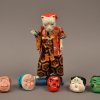 |
Okagura Ningyo (Mask-Dance Doll) |
This Okagura Ningyo, or "Mask-Dance Doll," is a small plaster actor doll with a set of six masks. "Okagura" refers to a traditional Japanese Shinto dance. The set, likely made by the former company Shirokiya, comes in a cardboard box. The front of the lid features an... |
AB XX 170 |
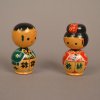 |
Kokeshi Doll |
This pair of small kokeshi dolls represents a boy and a girl. They dolls are a variation on the traditional kokeshi form, with round heads and bodies, but no arms or legs, as is typical. The heads are joined to the bodies by a dowel, and can swivel around. The boy (a) is... |
AB XX 177 a,b |
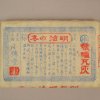 |
Charcoal |
This package of charcoal sticks is unopened, containing 10 sticks. The charcoal sticks, called kairobai, are long, cylindrical tubes. The front of the package is covered in red and blue text in Japanese. Kairo refers to the container that holds the slow-burning charcoal sticks... |
AB XX 182 |
 |
Tengu Mask |
This plastic mask represents the tengu, a goblin-like figure from Japanese folklore. It has a red face and white moustache and eyebrows, as well as the tengu's characteristically long nose and black cap held on by a gold cord. There is a thin elastic band attached to the back... |
AB XX 193 |
 |
Sake Cup Set |
This set of five sake cups (guinomi) are made of lacquered wood painted red on the outside and gold on the inside. Four of the cups feature flower designs (including an iris, cherry blossoms, plum blossoms, and a chrysanthemum) for each of the seasons; the other cup features a... |
AB XX 29 |
|
|
Netsuke Beads |
This thin gold cord is strung with four miniature netsuke beads and tied in a knot at the bottom. The carvings consist of (from bottom to top): a brown mouse curled up in a ball with its tail wrapped around itself; a round-faced, pudgy child with his arms and legs wrapped around the... |
AB XX 59 |
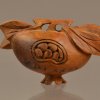 |
Pomegranate Netsuke |
This carved wooden netsuke takes the shape of a pomegranate. It has a bulbous shape with a puckered opening at the bottom and one side is "cut" open to reveal the pomegranate seeds inside. The pomegranate grows from a small branch next two two pairs of leaves. |
AB XX 61 |
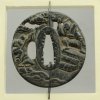 |
Tsuba |
This iron tsuba (sword guard) is circular in shape, and each side features a raised-relief image. One side depicts two figures looking at each other beneath pine trees; the figure on the right is standing on a stone stairway and is dressed in feudal clothing while the figure on the... |
AB XX 80 |
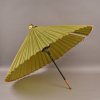 |
Wagasa (Parasol) |
This wagasa is made of green washi paper on a bamboo frame. There are two layers of white kagari-ito, the decorative weave of strings that is tied on the inside ribbing structure. The wagasa is coated with oil (most likely linseed oil) to protect the user... |
AB XX 81 |
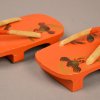 |
Geta |
This pair of a young girl's geta (sandals) is made of orange lacquered wood with a painted floral design in brown and gold. The shoes are painted as mirror images, with blue and gold curves on one side and a circular design with blue petals on other. They have tan and orange velveteen... |
AB XX 96 |
 |
Hotei-san |
This figurine represents the Lucky God Hotei, God of Happiness. This Hotei is made of a brown earthenware, and is skinnier than the other eight figures. He holds his characteristic fan in both hands, and a cord securing his robe is tied in a bow in the front. He has large earlobes and an open-... |
TC AB 2014.1.1 |
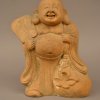 |
Hotei-san |
This figurine represents the Lucky God Hotei, God of Happiness. He is one of nine statues of the god that were collected by the original owners of the Japanese House and remains part of the house today. This particular Hotei is made of a brown stone or earthenware, and has the most traditional... |
TC AB 2014.1.4 |
 |
Hotei-san |
This figurine represents Hotei, the God of Happiness, one of the Taoist Seven Lucky Gods. This Hotei is depicted with his characteristic large, bare belly, large earlobes, and holding a fan in one hand and a rucksack at his feet. The Hotei may have once been painted, but is now a gray-brown... |
TC AB 2014.1.7 |
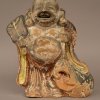 |
Hotei-san |
This figurine represents Hotei, the God of Happiness, one of the Taoist Seven Lucky Gods. This Hotei is depicted with his characteristic large, bare belly, large earlobes, and holding a fan in one hand and a rucksack at his feet. The Hotei may have once been painted, but is now a gray-brown... |
TC AB 2014.1.9 |